Health and Safety in Care Settings
VerifiedAdded on 2023/01/05
|25
|7663
|76
AI Summary
This document provides information on health and safety in care settings, including legislation, policies, and procedures. It outlines the responsibilities of employees and employers in preventing and controlling infections. It also explains safe practices for moving and handling equipment and hazardous substances. The content covers various topics such as identifying legislation, outlining procedures, accessing support, assessing risks, reporting potential risks, addressing dilemmas, describing accidents and sudden illnesses, explaining roles and responsibilities, understanding causes and spread of infections, identifying legislation related to moving and handling, describing hazardous substances, and practicing fire prevention.
Contribute Materials
Your contribution can guide someone’s learning journey. Share your
documents today.
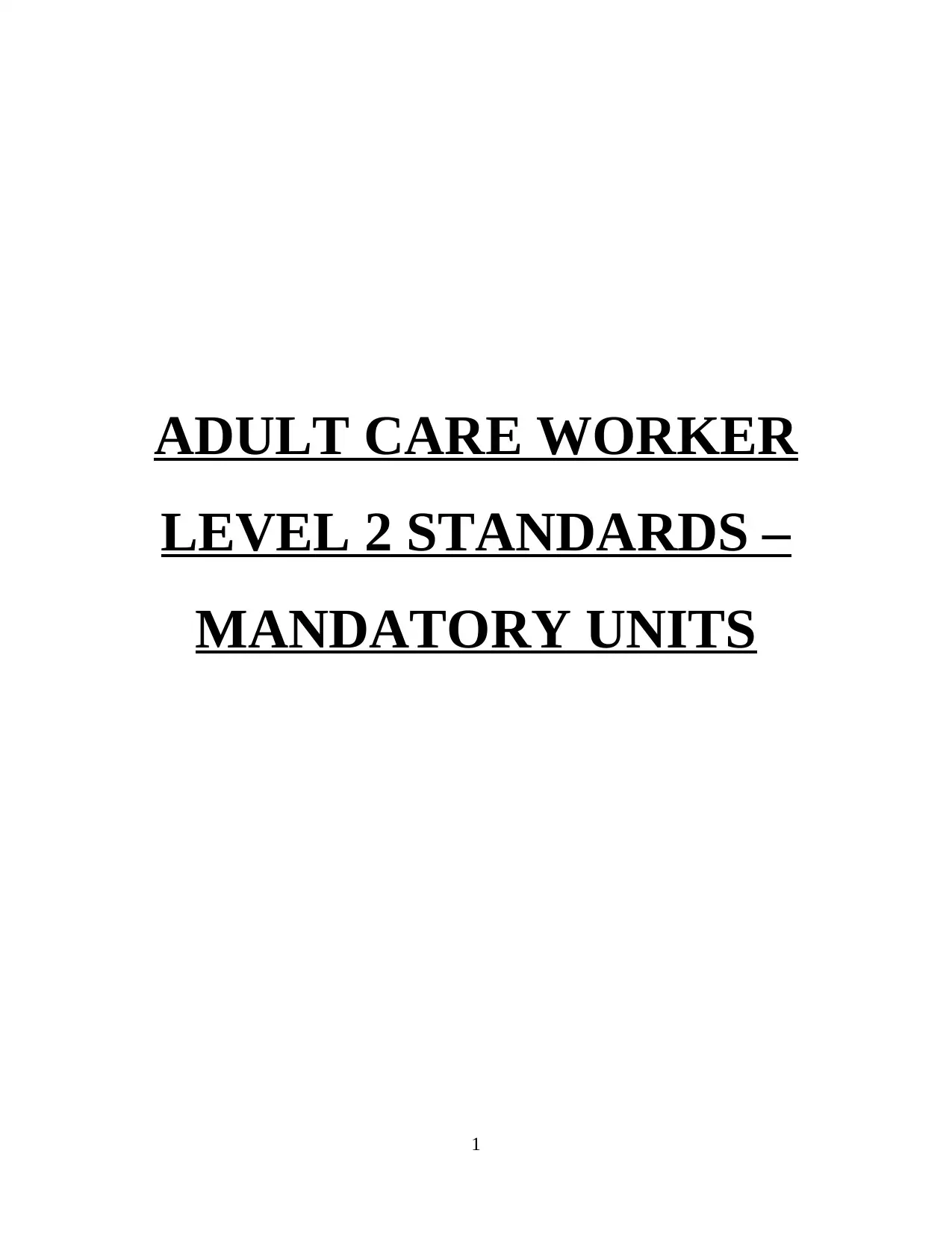
ADULT CARE WORKER
LEVEL 2 STANDARDS –
MANDATORY UNITS
1
LEVEL 2 STANDARDS –
MANDATORY UNITS
1
Secure Best Marks with AI Grader
Need help grading? Try our AI Grader for instant feedback on your assignments.

2
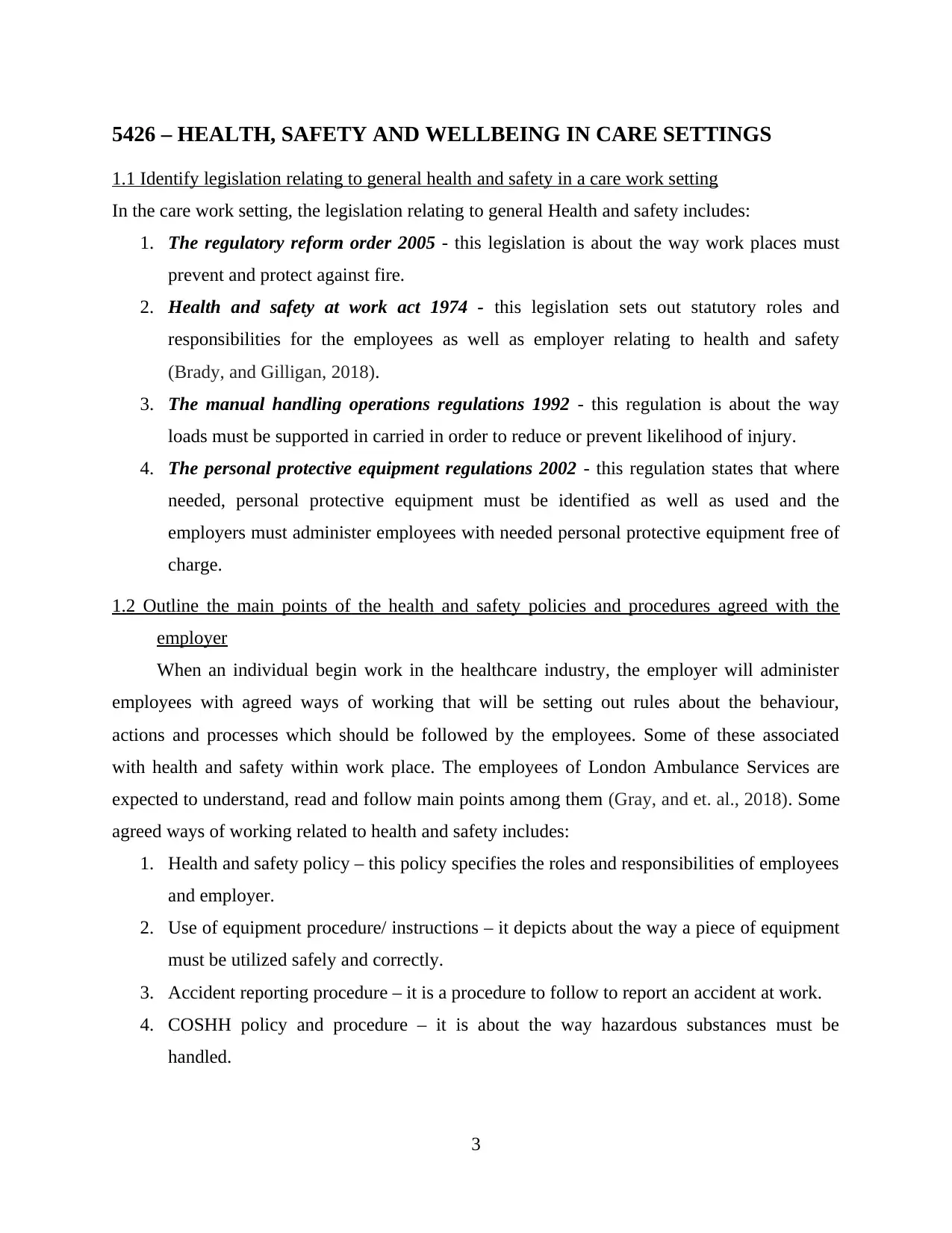
5426 – HEALTH, SAFETY AND WELLBEING IN CARE SETTINGS
1.1 Identify legislation relating to general health and safety in a care work setting
In the care work setting, the legislation relating to general Health and safety includes:
1. The regulatory reform order 2005 - this legislation is about the way work places must
prevent and protect against fire.
2. Health and safety at work act 1974 - this legislation sets out statutory roles and
responsibilities for the employees as well as employer relating to health and safety
(Brady, and Gilligan, 2018).
3. The manual handling operations regulations 1992 - this regulation is about the way
loads must be supported in carried in order to reduce or prevent likelihood of injury.
4. The personal protective equipment regulations 2002 - this regulation states that where
needed, personal protective equipment must be identified as well as used and the
employers must administer employees with needed personal protective equipment free of
charge.
1.2 Outline the main points of the health and safety policies and procedures agreed with the
employer
When an individual begin work in the healthcare industry, the employer will administer
employees with agreed ways of working that will be setting out rules about the behaviour,
actions and processes which should be followed by the employees. Some of these associated
with health and safety within work place. The employees of London Ambulance Services are
expected to understand, read and follow main points among them (Gray, and et. al., 2018). Some
agreed ways of working related to health and safety includes:
1. Health and safety policy – this policy specifies the roles and responsibilities of employees
and employer.
2. Use of equipment procedure/ instructions – it depicts about the way a piece of equipment
must be utilized safely and correctly.
3. Accident reporting procedure – it is a procedure to follow to report an accident at work.
4. COSHH policy and procedure – it is about the way hazardous substances must be
handled.
3
1.1 Identify legislation relating to general health and safety in a care work setting
In the care work setting, the legislation relating to general Health and safety includes:
1. The regulatory reform order 2005 - this legislation is about the way work places must
prevent and protect against fire.
2. Health and safety at work act 1974 - this legislation sets out statutory roles and
responsibilities for the employees as well as employer relating to health and safety
(Brady, and Gilligan, 2018).
3. The manual handling operations regulations 1992 - this regulation is about the way
loads must be supported in carried in order to reduce or prevent likelihood of injury.
4. The personal protective equipment regulations 2002 - this regulation states that where
needed, personal protective equipment must be identified as well as used and the
employers must administer employees with needed personal protective equipment free of
charge.
1.2 Outline the main points of the health and safety policies and procedures agreed with the
employer
When an individual begin work in the healthcare industry, the employer will administer
employees with agreed ways of working that will be setting out rules about the behaviour,
actions and processes which should be followed by the employees. Some of these associated
with health and safety within work place. The employees of London Ambulance Services are
expected to understand, read and follow main points among them (Gray, and et. al., 2018). Some
agreed ways of working related to health and safety includes:
1. Health and safety policy – this policy specifies the roles and responsibilities of employees
and employer.
2. Use of equipment procedure/ instructions – it depicts about the way a piece of equipment
must be utilized safely and correctly.
3. Accident reporting procedure – it is a procedure to follow to report an accident at work.
4. COSHH policy and procedure – it is about the way hazardous substances must be
handled.
3
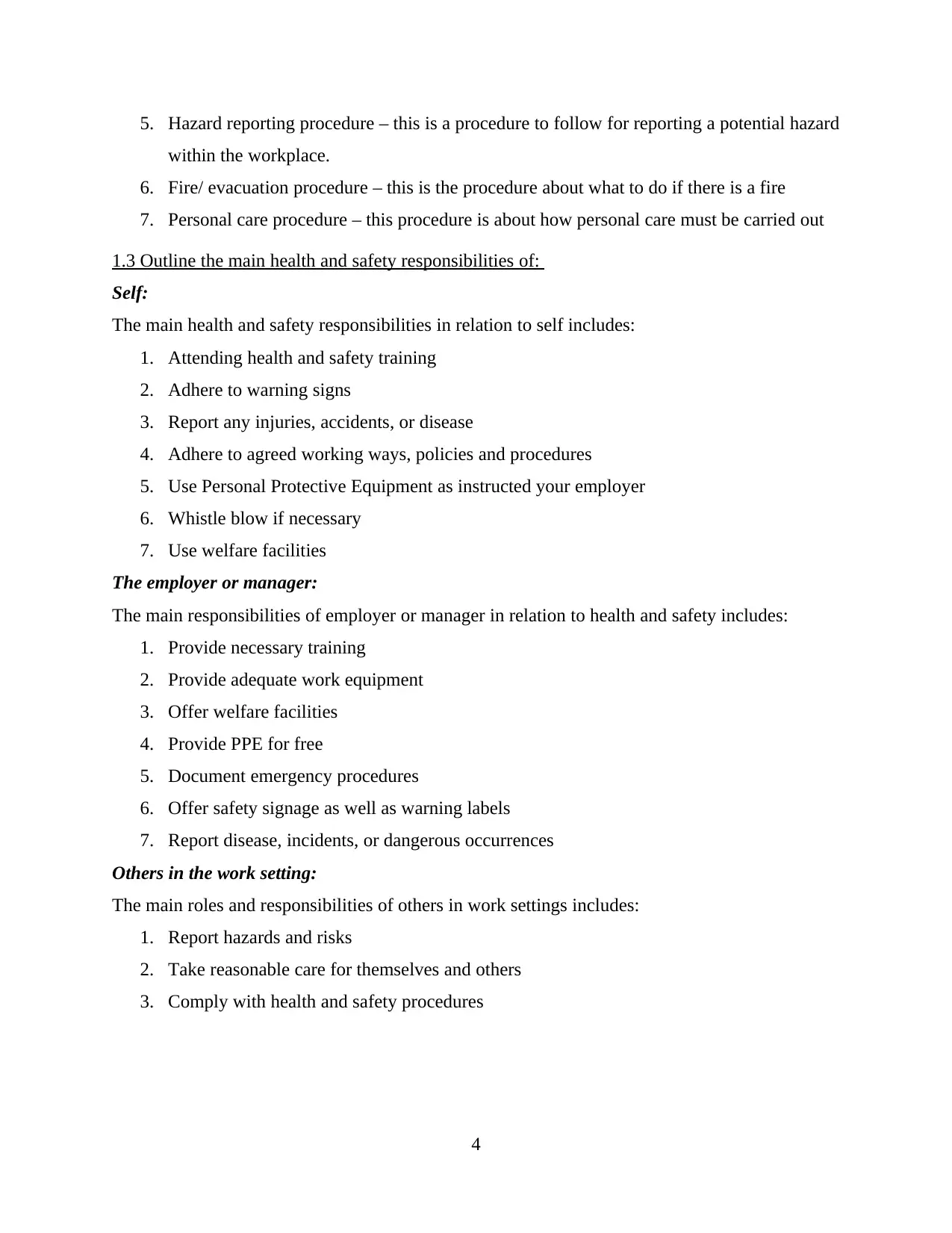
5. Hazard reporting procedure – this is a procedure to follow for reporting a potential hazard
within the workplace.
6. Fire/ evacuation procedure – this is the procedure about what to do if there is a fire
7. Personal care procedure – this procedure is about how personal care must be carried out
1.3 Outline the main health and safety responsibilities of:
Self:
The main health and safety responsibilities in relation to self includes:
1. Attending health and safety training
2. Adhere to warning signs
3. Report any injuries, accidents, or disease
4. Adhere to agreed working ways, policies and procedures
5. Use Personal Protective Equipment as instructed your employer
6. Whistle blow if necessary
7. Use welfare facilities
The employer or manager:
The main responsibilities of employer or manager in relation to health and safety includes:
1. Provide necessary training
2. Provide adequate work equipment
3. Offer welfare facilities
4. Provide PPE for free
5. Document emergency procedures
6. Offer safety signage as well as warning labels
7. Report disease, incidents, or dangerous occurrences
Others in the work setting:
The main roles and responsibilities of others in work settings includes:
1. Report hazards and risks
2. Take reasonable care for themselves and others
3. Comply with health and safety procedures
4
within the workplace.
6. Fire/ evacuation procedure – this is the procedure about what to do if there is a fire
7. Personal care procedure – this procedure is about how personal care must be carried out
1.3 Outline the main health and safety responsibilities of:
Self:
The main health and safety responsibilities in relation to self includes:
1. Attending health and safety training
2. Adhere to warning signs
3. Report any injuries, accidents, or disease
4. Adhere to agreed working ways, policies and procedures
5. Use Personal Protective Equipment as instructed your employer
6. Whistle blow if necessary
7. Use welfare facilities
The employer or manager:
The main responsibilities of employer or manager in relation to health and safety includes:
1. Provide necessary training
2. Provide adequate work equipment
3. Offer welfare facilities
4. Provide PPE for free
5. Document emergency procedures
6. Offer safety signage as well as warning labels
7. Report disease, incidents, or dangerous occurrences
Others in the work setting:
The main roles and responsibilities of others in work settings includes:
1. Report hazards and risks
2. Take reasonable care for themselves and others
3. Comply with health and safety procedures
4
Secure Best Marks with AI Grader
Need help grading? Try our AI Grader for instant feedback on your assignments.
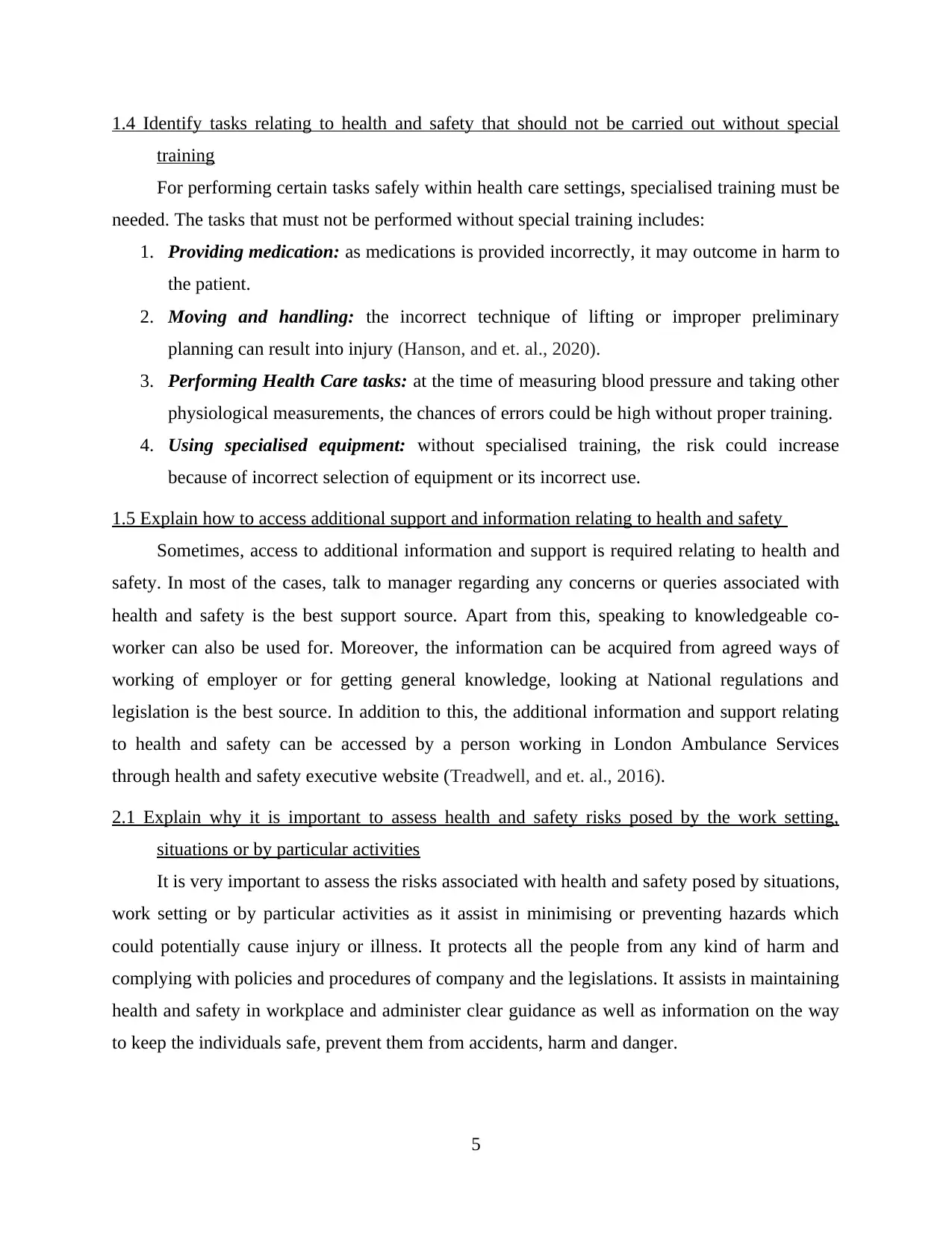
1.4 Identify tasks relating to health and safety that should not be carried out without special
training
For performing certain tasks safely within health care settings, specialised training must be
needed. The tasks that must not be performed without special training includes:
1. Providing medication: as medications is provided incorrectly, it may outcome in harm to
the patient.
2. Moving and handling: the incorrect technique of lifting or improper preliminary
planning can result into injury (Hanson, and et. al., 2020).
3. Performing Health Care tasks: at the time of measuring blood pressure and taking other
physiological measurements, the chances of errors could be high without proper training.
4. Using specialised equipment: without specialised training, the risk could increase
because of incorrect selection of equipment or its incorrect use.
1.5 Explain how to access additional support and information relating to health and safety
Sometimes, access to additional information and support is required relating to health and
safety. In most of the cases, talk to manager regarding any concerns or queries associated with
health and safety is the best support source. Apart from this, speaking to knowledgeable co-
worker can also be used for. Moreover, the information can be acquired from agreed ways of
working of employer or for getting general knowledge, looking at National regulations and
legislation is the best source. In addition to this, the additional information and support relating
to health and safety can be accessed by a person working in London Ambulance Services
through health and safety executive website (Treadwell, and et. al., 2016).
2.1 Explain why it is important to assess health and safety risks posed by the work setting,
situations or by particular activities
It is very important to assess the risks associated with health and safety posed by situations,
work setting or by particular activities as it assist in minimising or preventing hazards which
could potentially cause injury or illness. It protects all the people from any kind of harm and
complying with policies and procedures of company and the legislations. It assists in maintaining
health and safety in workplace and administer clear guidance as well as information on the way
to keep the individuals safe, prevent them from accidents, harm and danger.
5
training
For performing certain tasks safely within health care settings, specialised training must be
needed. The tasks that must not be performed without special training includes:
1. Providing medication: as medications is provided incorrectly, it may outcome in harm to
the patient.
2. Moving and handling: the incorrect technique of lifting or improper preliminary
planning can result into injury (Hanson, and et. al., 2020).
3. Performing Health Care tasks: at the time of measuring blood pressure and taking other
physiological measurements, the chances of errors could be high without proper training.
4. Using specialised equipment: without specialised training, the risk could increase
because of incorrect selection of equipment or its incorrect use.
1.5 Explain how to access additional support and information relating to health and safety
Sometimes, access to additional information and support is required relating to health and
safety. In most of the cases, talk to manager regarding any concerns or queries associated with
health and safety is the best support source. Apart from this, speaking to knowledgeable co-
worker can also be used for. Moreover, the information can be acquired from agreed ways of
working of employer or for getting general knowledge, looking at National regulations and
legislation is the best source. In addition to this, the additional information and support relating
to health and safety can be accessed by a person working in London Ambulance Services
through health and safety executive website (Treadwell, and et. al., 2016).
2.1 Explain why it is important to assess health and safety risks posed by the work setting,
situations or by particular activities
It is very important to assess the risks associated with health and safety posed by situations,
work setting or by particular activities as it assist in minimising or preventing hazards which
could potentially cause injury or illness. It protects all the people from any kind of harm and
complying with policies and procedures of company and the legislations. It assists in maintaining
health and safety in workplace and administer clear guidance as well as information on the way
to keep the individuals safe, prevent them from accidents, harm and danger.
5
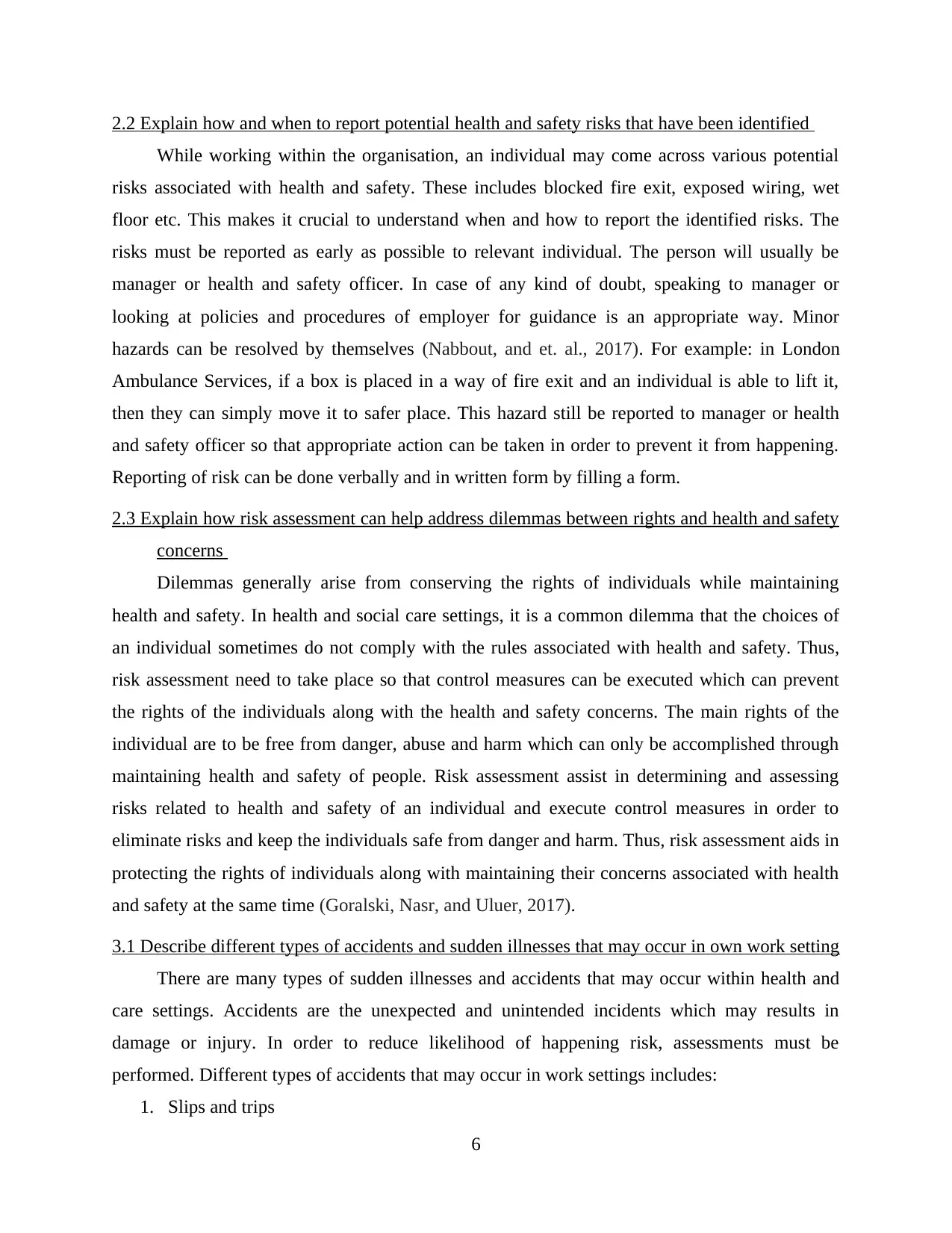
2.2 Explain how and when to report potential health and safety risks that have been identified
While working within the organisation, an individual may come across various potential
risks associated with health and safety. These includes blocked fire exit, exposed wiring, wet
floor etc. This makes it crucial to understand when and how to report the identified risks. The
risks must be reported as early as possible to relevant individual. The person will usually be
manager or health and safety officer. In case of any kind of doubt, speaking to manager or
looking at policies and procedures of employer for guidance is an appropriate way. Minor
hazards can be resolved by themselves (Nabbout, and et. al., 2017). For example: in London
Ambulance Services, if a box is placed in a way of fire exit and an individual is able to lift it,
then they can simply move it to safer place. This hazard still be reported to manager or health
and safety officer so that appropriate action can be taken in order to prevent it from happening.
Reporting of risk can be done verbally and in written form by filling a form.
2.3 Explain how risk assessment can help address dilemmas between rights and health and safety
concerns
Dilemmas generally arise from conserving the rights of individuals while maintaining
health and safety. In health and social care settings, it is a common dilemma that the choices of
an individual sometimes do not comply with the rules associated with health and safety. Thus,
risk assessment need to take place so that control measures can be executed which can prevent
the rights of the individuals along with the health and safety concerns. The main rights of the
individual are to be free from danger, abuse and harm which can only be accomplished through
maintaining health and safety of people. Risk assessment assist in determining and assessing
risks related to health and safety of an individual and execute control measures in order to
eliminate risks and keep the individuals safe from danger and harm. Thus, risk assessment aids in
protecting the rights of individuals along with maintaining their concerns associated with health
and safety at the same time (Goralski, Nasr, and Uluer, 2017).
3.1 Describe different types of accidents and sudden illnesses that may occur in own work setting
There are many types of sudden illnesses and accidents that may occur within health and
care settings. Accidents are the unexpected and unintended incidents which may results in
damage or injury. In order to reduce likelihood of happening risk, assessments must be
performed. Different types of accidents that may occur in work settings includes:
1. Slips and trips
6
While working within the organisation, an individual may come across various potential
risks associated with health and safety. These includes blocked fire exit, exposed wiring, wet
floor etc. This makes it crucial to understand when and how to report the identified risks. The
risks must be reported as early as possible to relevant individual. The person will usually be
manager or health and safety officer. In case of any kind of doubt, speaking to manager or
looking at policies and procedures of employer for guidance is an appropriate way. Minor
hazards can be resolved by themselves (Nabbout, and et. al., 2017). For example: in London
Ambulance Services, if a box is placed in a way of fire exit and an individual is able to lift it,
then they can simply move it to safer place. This hazard still be reported to manager or health
and safety officer so that appropriate action can be taken in order to prevent it from happening.
Reporting of risk can be done verbally and in written form by filling a form.
2.3 Explain how risk assessment can help address dilemmas between rights and health and safety
concerns
Dilemmas generally arise from conserving the rights of individuals while maintaining
health and safety. In health and social care settings, it is a common dilemma that the choices of
an individual sometimes do not comply with the rules associated with health and safety. Thus,
risk assessment need to take place so that control measures can be executed which can prevent
the rights of the individuals along with the health and safety concerns. The main rights of the
individual are to be free from danger, abuse and harm which can only be accomplished through
maintaining health and safety of people. Risk assessment assist in determining and assessing
risks related to health and safety of an individual and execute control measures in order to
eliminate risks and keep the individuals safe from danger and harm. Thus, risk assessment aids in
protecting the rights of individuals along with maintaining their concerns associated with health
and safety at the same time (Goralski, Nasr, and Uluer, 2017).
3.1 Describe different types of accidents and sudden illnesses that may occur in own work setting
There are many types of sudden illnesses and accidents that may occur within health and
care settings. Accidents are the unexpected and unintended incidents which may results in
damage or injury. In order to reduce likelihood of happening risk, assessments must be
performed. Different types of accidents that may occur in work settings includes:
1. Slips and trips
6
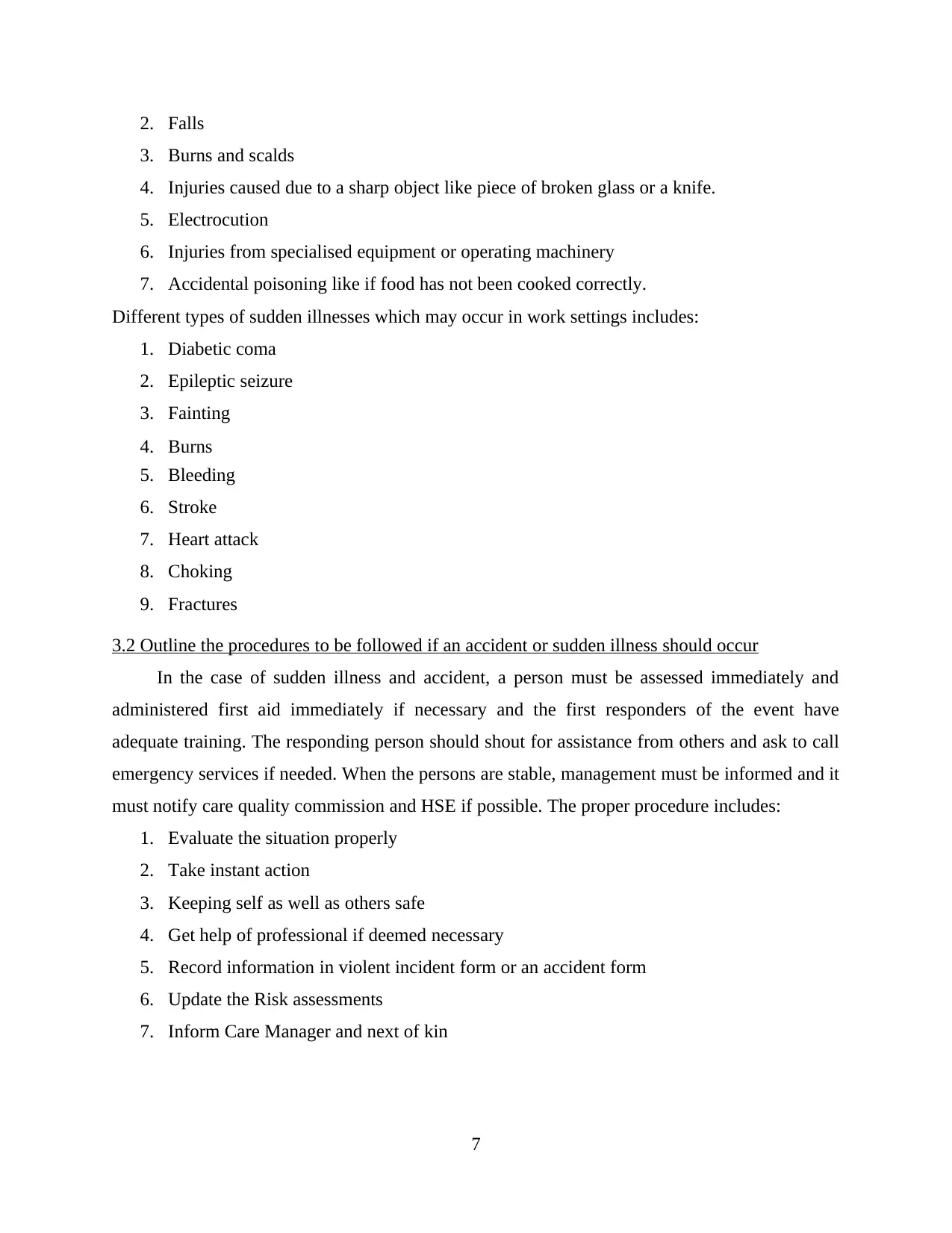
2. Falls
3. Burns and scalds
4. Injuries caused due to a sharp object like piece of broken glass or a knife.
5. Electrocution
6. Injuries from specialised equipment or operating machinery
7. Accidental poisoning like if food has not been cooked correctly.
Different types of sudden illnesses which may occur in work settings includes:
1. Diabetic coma
2. Epileptic seizure
3. Fainting
4. Burns
5. Bleeding
6. Stroke
7. Heart attack
8. Choking
9. Fractures
3.2 Outline the procedures to be followed if an accident or sudden illness should occur
In the case of sudden illness and accident, a person must be assessed immediately and
administered first aid immediately if necessary and the first responders of the event have
adequate training. The responding person should shout for assistance from others and ask to call
emergency services if needed. When the persons are stable, management must be informed and it
must notify care quality commission and HSE if possible. The proper procedure includes:
1. Evaluate the situation properly
2. Take instant action
3. Keeping self as well as others safe
4. Get help of professional if deemed necessary
5. Record information in violent incident form or an accident form
6. Update the Risk assessments
7. Inform Care Manager and next of kin
7
3. Burns and scalds
4. Injuries caused due to a sharp object like piece of broken glass or a knife.
5. Electrocution
6. Injuries from specialised equipment or operating machinery
7. Accidental poisoning like if food has not been cooked correctly.
Different types of sudden illnesses which may occur in work settings includes:
1. Diabetic coma
2. Epileptic seizure
3. Fainting
4. Burns
5. Bleeding
6. Stroke
7. Heart attack
8. Choking
9. Fractures
3.2 Outline the procedures to be followed if an accident or sudden illness should occur
In the case of sudden illness and accident, a person must be assessed immediately and
administered first aid immediately if necessary and the first responders of the event have
adequate training. The responding person should shout for assistance from others and ask to call
emergency services if needed. When the persons are stable, management must be informed and it
must notify care quality commission and HSE if possible. The proper procedure includes:
1. Evaluate the situation properly
2. Take instant action
3. Keeping self as well as others safe
4. Get help of professional if deemed necessary
5. Record information in violent incident form or an accident form
6. Update the Risk assessments
7. Inform Care Manager and next of kin
7
Paraphrase This Document
Need a fresh take? Get an instant paraphrase of this document with our AI Paraphraser
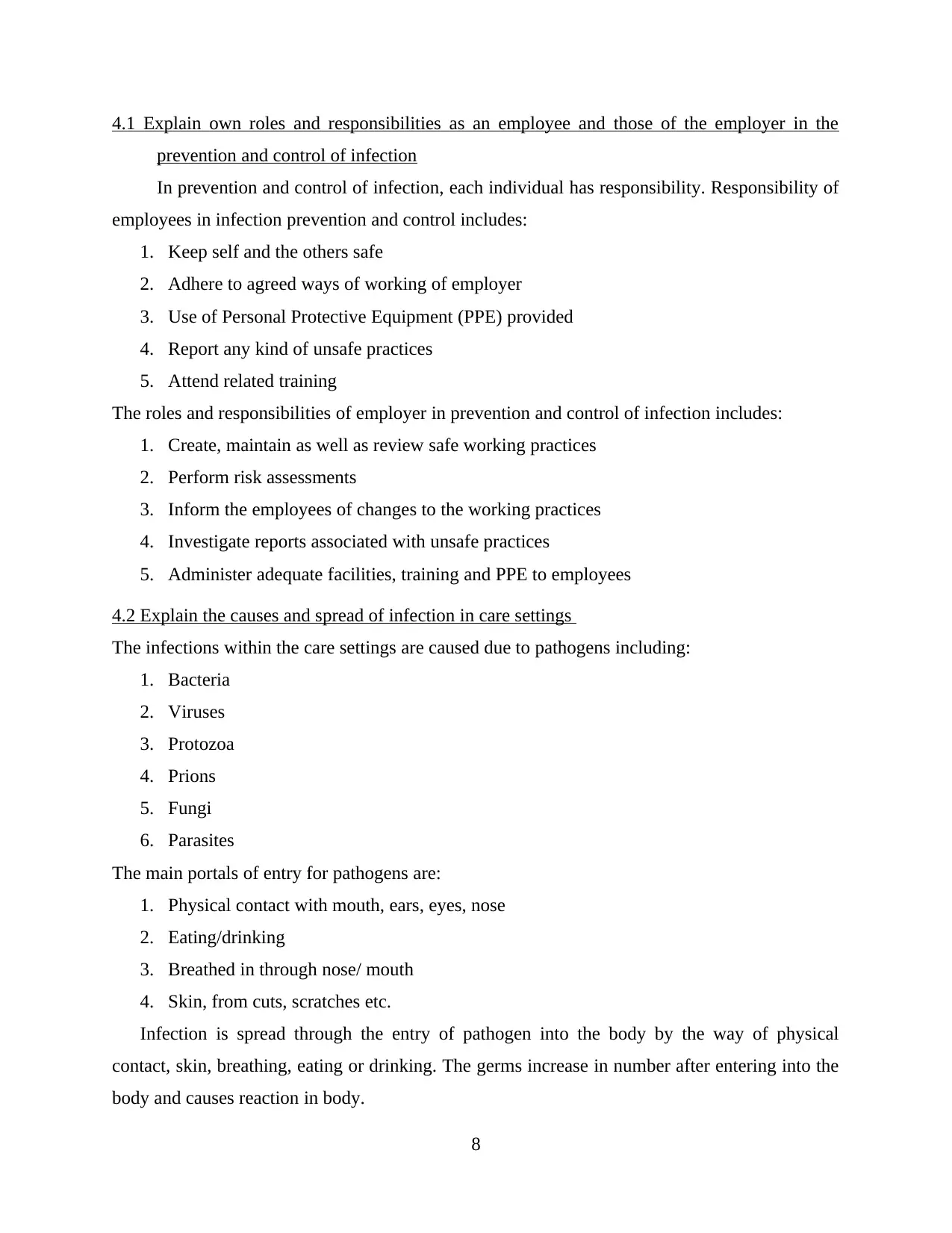
4.1 Explain own roles and responsibilities as an employee and those of the employer in the
prevention and control of infection
In prevention and control of infection, each individual has responsibility. Responsibility of
employees in infection prevention and control includes:
1. Keep self and the others safe
2. Adhere to agreed ways of working of employer
3. Use of Personal Protective Equipment (PPE) provided
4. Report any kind of unsafe practices
5. Attend related training
The roles and responsibilities of employer in prevention and control of infection includes:
1. Create, maintain as well as review safe working practices
2. Perform risk assessments
3. Inform the employees of changes to the working practices
4. Investigate reports associated with unsafe practices
5. Administer adequate facilities, training and PPE to employees
4.2 Explain the causes and spread of infection in care settings
The infections within the care settings are caused due to pathogens including:
1. Bacteria
2. Viruses
3. Protozoa
4. Prions
5. Fungi
6. Parasites
The main portals of entry for pathogens are:
1. Physical contact with mouth, ears, eyes, nose
2. Eating/drinking
3. Breathed in through nose/ mouth
4. Skin, from cuts, scratches etc.
Infection is spread through the entry of pathogen into the body by the way of physical
contact, skin, breathing, eating or drinking. The germs increase in number after entering into the
body and causes reaction in body.
8
prevention and control of infection
In prevention and control of infection, each individual has responsibility. Responsibility of
employees in infection prevention and control includes:
1. Keep self and the others safe
2. Adhere to agreed ways of working of employer
3. Use of Personal Protective Equipment (PPE) provided
4. Report any kind of unsafe practices
5. Attend related training
The roles and responsibilities of employer in prevention and control of infection includes:
1. Create, maintain as well as review safe working practices
2. Perform risk assessments
3. Inform the employees of changes to the working practices
4. Investigate reports associated with unsafe practices
5. Administer adequate facilities, training and PPE to employees
4.2 Explain the causes and spread of infection in care settings
The infections within the care settings are caused due to pathogens including:
1. Bacteria
2. Viruses
3. Protozoa
4. Prions
5. Fungi
6. Parasites
The main portals of entry for pathogens are:
1. Physical contact with mouth, ears, eyes, nose
2. Eating/drinking
3. Breathed in through nose/ mouth
4. Skin, from cuts, scratches etc.
Infection is spread through the entry of pathogen into the body by the way of physical
contact, skin, breathing, eating or drinking. The germs increase in number after entering into the
body and causes reaction in body.
8
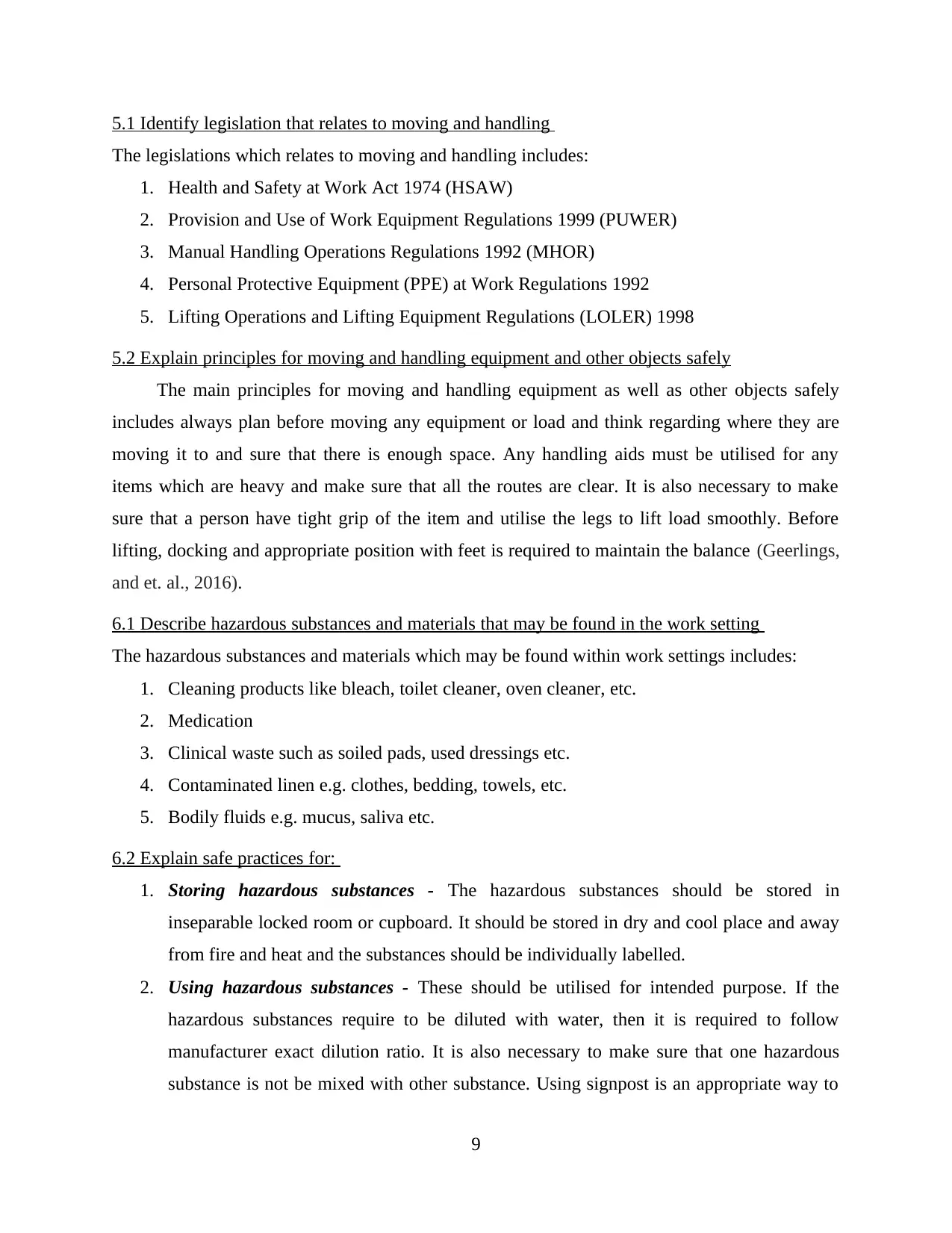
5.1 Identify legislation that relates to moving and handling
The legislations which relates to moving and handling includes:
1. Health and Safety at Work Act 1974 (HSAW)
2. Provision and Use of Work Equipment Regulations 1999 (PUWER)
3. Manual Handling Operations Regulations 1992 (MHOR)
4. Personal Protective Equipment (PPE) at Work Regulations 1992
5. Lifting Operations and Lifting Equipment Regulations (LOLER) 1998
5.2 Explain principles for moving and handling equipment and other objects safely
The main principles for moving and handling equipment as well as other objects safely
includes always plan before moving any equipment or load and think regarding where they are
moving it to and sure that there is enough space. Any handling aids must be utilised for any
items which are heavy and make sure that all the routes are clear. It is also necessary to make
sure that a person have tight grip of the item and utilise the legs to lift load smoothly. Before
lifting, docking and appropriate position with feet is required to maintain the balance (Geerlings,
and et. al., 2016).
6.1 Describe hazardous substances and materials that may be found in the work setting
The hazardous substances and materials which may be found within work settings includes:
1. Cleaning products like bleach, toilet cleaner, oven cleaner, etc.
2. Medication
3. Clinical waste such as soiled pads, used dressings etc.
4. Contaminated linen e.g. clothes, bedding, towels, etc.
5. Bodily fluids e.g. mucus, saliva etc.
6.2 Explain safe practices for:
1. Storing hazardous substances - The hazardous substances should be stored in
inseparable locked room or cupboard. It should be stored in dry and cool place and away
from fire and heat and the substances should be individually labelled.
2. Using hazardous substances - These should be utilised for intended purpose. If the
hazardous substances require to be diluted with water, then it is required to follow
manufacturer exact dilution ratio. It is also necessary to make sure that one hazardous
substance is not be mixed with other substance. Using signpost is an appropriate way to
9
The legislations which relates to moving and handling includes:
1. Health and Safety at Work Act 1974 (HSAW)
2. Provision and Use of Work Equipment Regulations 1999 (PUWER)
3. Manual Handling Operations Regulations 1992 (MHOR)
4. Personal Protective Equipment (PPE) at Work Regulations 1992
5. Lifting Operations and Lifting Equipment Regulations (LOLER) 1998
5.2 Explain principles for moving and handling equipment and other objects safely
The main principles for moving and handling equipment as well as other objects safely
includes always plan before moving any equipment or load and think regarding where they are
moving it to and sure that there is enough space. Any handling aids must be utilised for any
items which are heavy and make sure that all the routes are clear. It is also necessary to make
sure that a person have tight grip of the item and utilise the legs to lift load smoothly. Before
lifting, docking and appropriate position with feet is required to maintain the balance (Geerlings,
and et. al., 2016).
6.1 Describe hazardous substances and materials that may be found in the work setting
The hazardous substances and materials which may be found within work settings includes:
1. Cleaning products like bleach, toilet cleaner, oven cleaner, etc.
2. Medication
3. Clinical waste such as soiled pads, used dressings etc.
4. Contaminated linen e.g. clothes, bedding, towels, etc.
5. Bodily fluids e.g. mucus, saliva etc.
6.2 Explain safe practices for:
1. Storing hazardous substances - The hazardous substances should be stored in
inseparable locked room or cupboard. It should be stored in dry and cool place and away
from fire and heat and the substances should be individually labelled.
2. Using hazardous substances - These should be utilised for intended purpose. If the
hazardous substances require to be diluted with water, then it is required to follow
manufacturer exact dilution ratio. It is also necessary to make sure that one hazardous
substance is not be mixed with other substance. Using signpost is an appropriate way to
9
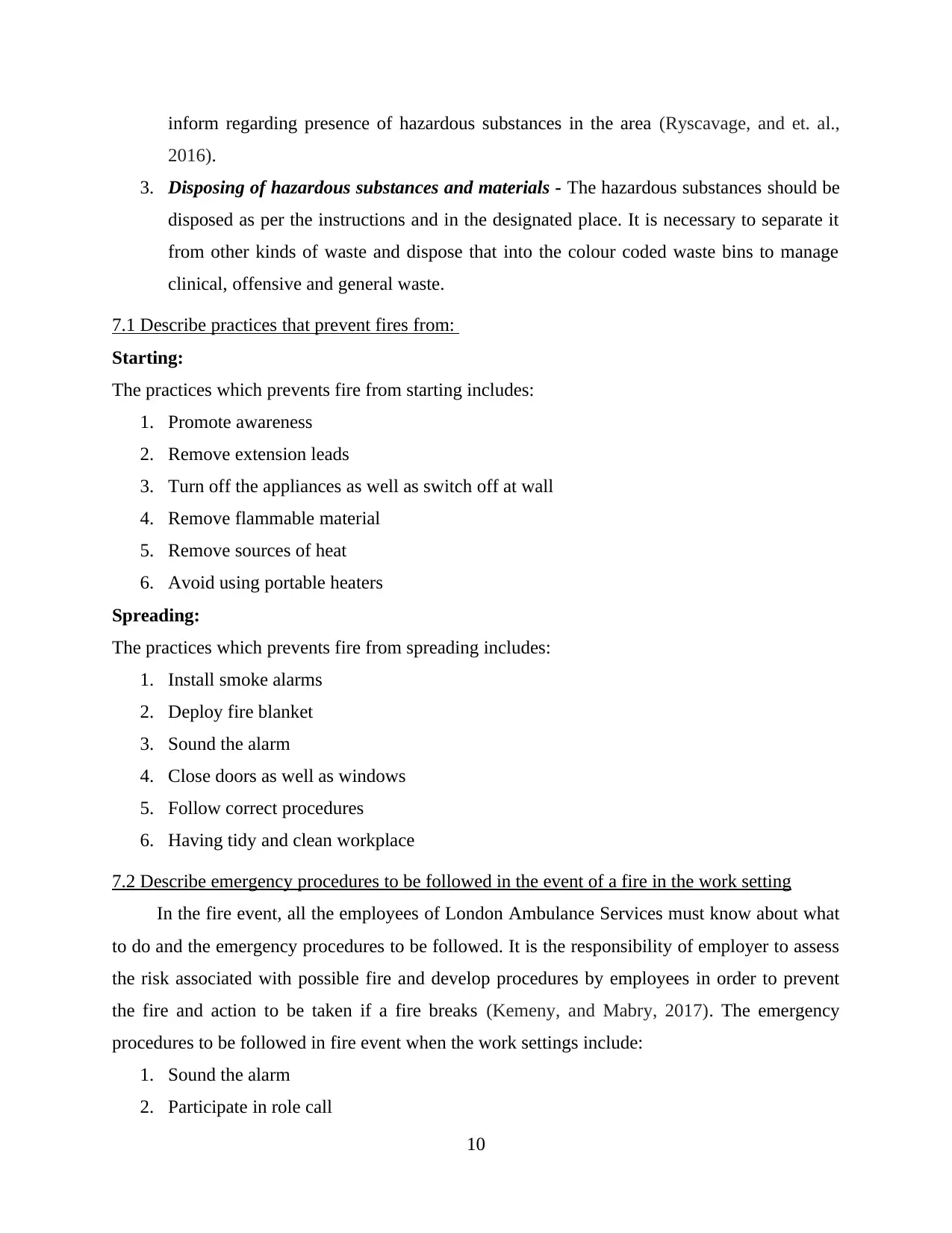
inform regarding presence of hazardous substances in the area (Ryscavage, and et. al.,
2016).
3. Disposing of hazardous substances and materials - The hazardous substances should be
disposed as per the instructions and in the designated place. It is necessary to separate it
from other kinds of waste and dispose that into the colour coded waste bins to manage
clinical, offensive and general waste.
7.1 Describe practices that prevent fires from:
Starting:
The practices which prevents fire from starting includes:
1. Promote awareness
2. Remove extension leads
3. Turn off the appliances as well as switch off at wall
4. Remove flammable material
5. Remove sources of heat
6. Avoid using portable heaters
Spreading:
The practices which prevents fire from spreading includes:
1. Install smoke alarms
2. Deploy fire blanket
3. Sound the alarm
4. Close doors as well as windows
5. Follow correct procedures
6. Having tidy and clean workplace
7.2 Describe emergency procedures to be followed in the event of a fire in the work setting
In the fire event, all the employees of London Ambulance Services must know about what
to do and the emergency procedures to be followed. It is the responsibility of employer to assess
the risk associated with possible fire and develop procedures by employees in order to prevent
the fire and action to be taken if a fire breaks (Kemeny, and Mabry, 2017). The emergency
procedures to be followed in fire event when the work settings include:
1. Sound the alarm
2. Participate in role call
10
2016).
3. Disposing of hazardous substances and materials - The hazardous substances should be
disposed as per the instructions and in the designated place. It is necessary to separate it
from other kinds of waste and dispose that into the colour coded waste bins to manage
clinical, offensive and general waste.
7.1 Describe practices that prevent fires from:
Starting:
The practices which prevents fire from starting includes:
1. Promote awareness
2. Remove extension leads
3. Turn off the appliances as well as switch off at wall
4. Remove flammable material
5. Remove sources of heat
6. Avoid using portable heaters
Spreading:
The practices which prevents fire from spreading includes:
1. Install smoke alarms
2. Deploy fire blanket
3. Sound the alarm
4. Close doors as well as windows
5. Follow correct procedures
6. Having tidy and clean workplace
7.2 Describe emergency procedures to be followed in the event of a fire in the work setting
In the fire event, all the employees of London Ambulance Services must know about what
to do and the emergency procedures to be followed. It is the responsibility of employer to assess
the risk associated with possible fire and develop procedures by employees in order to prevent
the fire and action to be taken if a fire breaks (Kemeny, and Mabry, 2017). The emergency
procedures to be followed in fire event when the work settings include:
1. Sound the alarm
2. Participate in role call
10
Secure Best Marks with AI Grader
Need help grading? Try our AI Grader for instant feedback on your assignments.
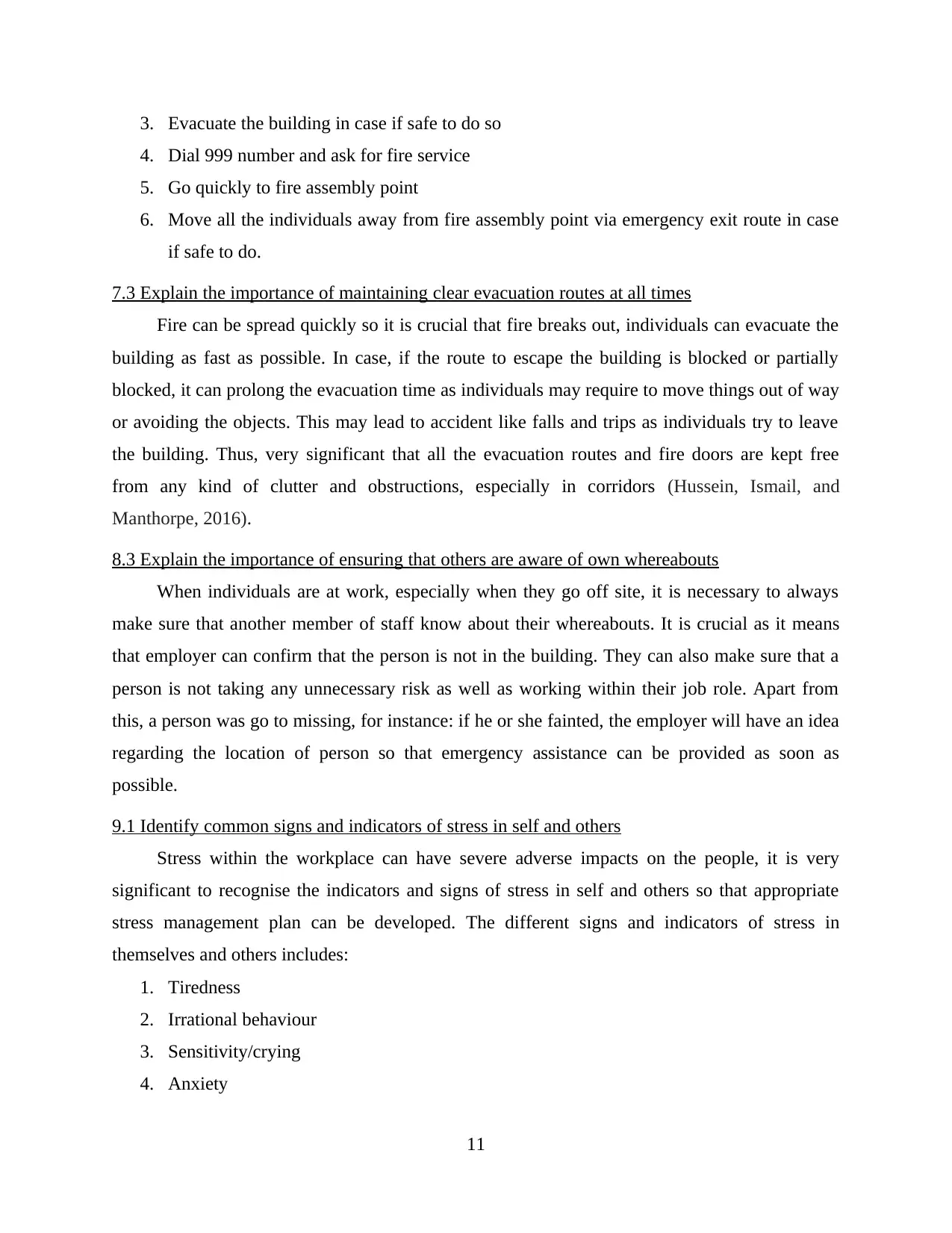
3. Evacuate the building in case if safe to do so
4. Dial 999 number and ask for fire service
5. Go quickly to fire assembly point
6. Move all the individuals away from fire assembly point via emergency exit route in case
if safe to do.
7.3 Explain the importance of maintaining clear evacuation routes at all times
Fire can be spread quickly so it is crucial that fire breaks out, individuals can evacuate the
building as fast as possible. In case, if the route to escape the building is blocked or partially
blocked, it can prolong the evacuation time as individuals may require to move things out of way
or avoiding the objects. This may lead to accident like falls and trips as individuals try to leave
the building. Thus, very significant that all the evacuation routes and fire doors are kept free
from any kind of clutter and obstructions, especially in corridors (Hussein, Ismail, and
Manthorpe, 2016).
8.3 Explain the importance of ensuring that others are aware of own whereabouts
When individuals are at work, especially when they go off site, it is necessary to always
make sure that another member of staff know about their whereabouts. It is crucial as it means
that employer can confirm that the person is not in the building. They can also make sure that a
person is not taking any unnecessary risk as well as working within their job role. Apart from
this, a person was go to missing, for instance: if he or she fainted, the employer will have an idea
regarding the location of person so that emergency assistance can be provided as soon as
possible.
9.1 Identify common signs and indicators of stress in self and others
Stress within the workplace can have severe adverse impacts on the people, it is very
significant to recognise the indicators and signs of stress in self and others so that appropriate
stress management plan can be developed. The different signs and indicators of stress in
themselves and others includes:
1. Tiredness
2. Irrational behaviour
3. Sensitivity/crying
4. Anxiety
11
4. Dial 999 number and ask for fire service
5. Go quickly to fire assembly point
6. Move all the individuals away from fire assembly point via emergency exit route in case
if safe to do.
7.3 Explain the importance of maintaining clear evacuation routes at all times
Fire can be spread quickly so it is crucial that fire breaks out, individuals can evacuate the
building as fast as possible. In case, if the route to escape the building is blocked or partially
blocked, it can prolong the evacuation time as individuals may require to move things out of way
or avoiding the objects. This may lead to accident like falls and trips as individuals try to leave
the building. Thus, very significant that all the evacuation routes and fire doors are kept free
from any kind of clutter and obstructions, especially in corridors (Hussein, Ismail, and
Manthorpe, 2016).
8.3 Explain the importance of ensuring that others are aware of own whereabouts
When individuals are at work, especially when they go off site, it is necessary to always
make sure that another member of staff know about their whereabouts. It is crucial as it means
that employer can confirm that the person is not in the building. They can also make sure that a
person is not taking any unnecessary risk as well as working within their job role. Apart from
this, a person was go to missing, for instance: if he or she fainted, the employer will have an idea
regarding the location of person so that emergency assistance can be provided as soon as
possible.
9.1 Identify common signs and indicators of stress in self and others
Stress within the workplace can have severe adverse impacts on the people, it is very
significant to recognise the indicators and signs of stress in self and others so that appropriate
stress management plan can be developed. The different signs and indicators of stress in
themselves and others includes:
1. Tiredness
2. Irrational behaviour
3. Sensitivity/crying
4. Anxiety
11
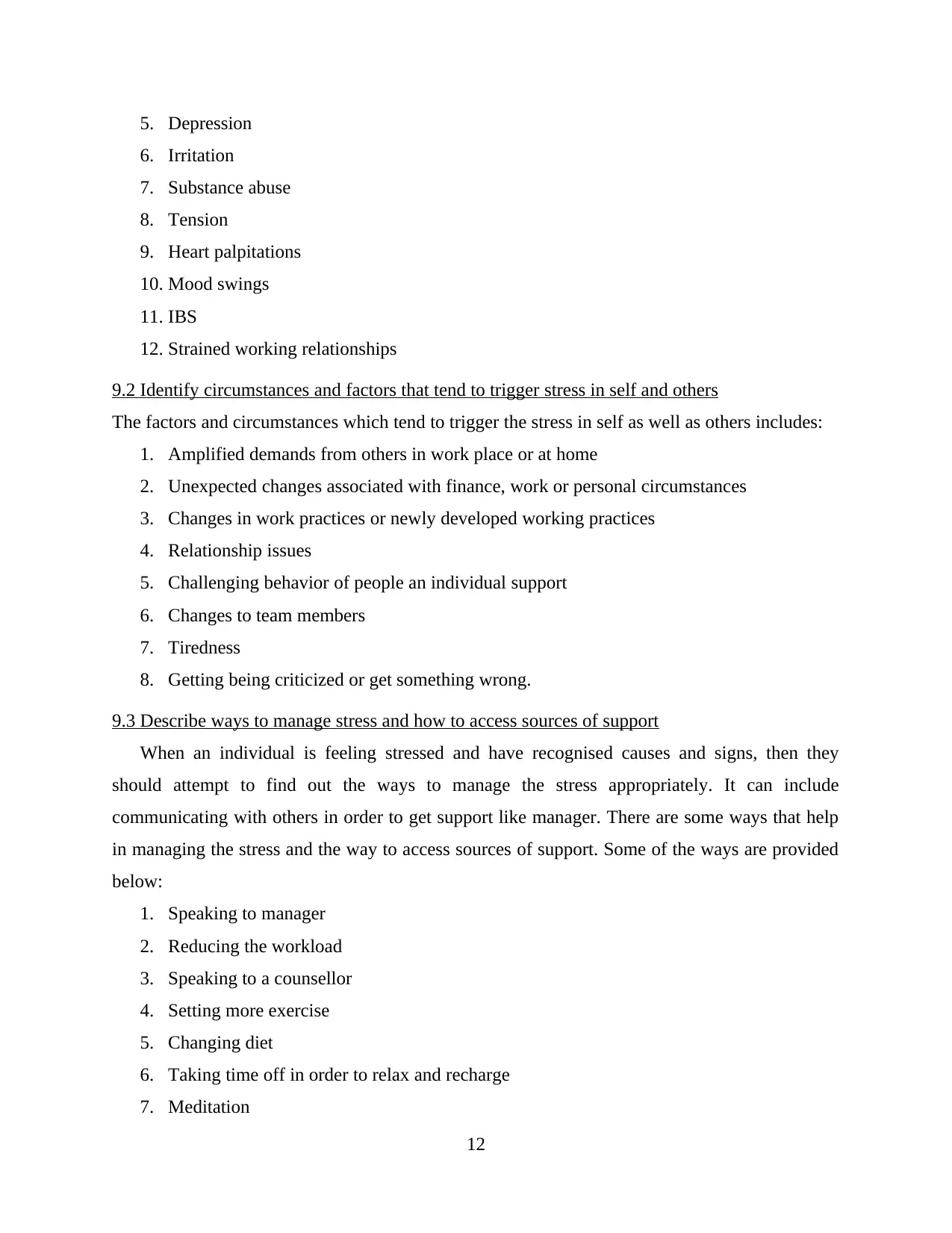
5. Depression
6. Irritation
7. Substance abuse
8. Tension
9. Heart palpitations
10. Mood swings
11. IBS
12. Strained working relationships
9.2 Identify circumstances and factors that tend to trigger stress in self and others
The factors and circumstances which tend to trigger the stress in self as well as others includes:
1. Amplified demands from others in work place or at home
2. Unexpected changes associated with finance, work or personal circumstances
3. Changes in work practices or newly developed working practices
4. Relationship issues
5. Challenging behavior of people an individual support
6. Changes to team members
7. Tiredness
8. Getting being criticized or get something wrong.
9.3 Describe ways to manage stress and how to access sources of support
When an individual is feeling stressed and have recognised causes and signs, then they
should attempt to find out the ways to manage the stress appropriately. It can include
communicating with others in order to get support like manager. There are some ways that help
in managing the stress and the way to access sources of support. Some of the ways are provided
below:
1. Speaking to manager
2. Reducing the workload
3. Speaking to a counsellor
4. Setting more exercise
5. Changing diet
6. Taking time off in order to relax and recharge
7. Meditation
12
6. Irritation
7. Substance abuse
8. Tension
9. Heart palpitations
10. Mood swings
11. IBS
12. Strained working relationships
9.2 Identify circumstances and factors that tend to trigger stress in self and others
The factors and circumstances which tend to trigger the stress in self as well as others includes:
1. Amplified demands from others in work place or at home
2. Unexpected changes associated with finance, work or personal circumstances
3. Changes in work practices or newly developed working practices
4. Relationship issues
5. Challenging behavior of people an individual support
6. Changes to team members
7. Tiredness
8. Getting being criticized or get something wrong.
9.3 Describe ways to manage stress and how to access sources of support
When an individual is feeling stressed and have recognised causes and signs, then they
should attempt to find out the ways to manage the stress appropriately. It can include
communicating with others in order to get support like manager. There are some ways that help
in managing the stress and the way to access sources of support. Some of the ways are provided
below:
1. Speaking to manager
2. Reducing the workload
3. Speaking to a counsellor
4. Setting more exercise
5. Changing diet
6. Taking time off in order to relax and recharge
7. Meditation
12
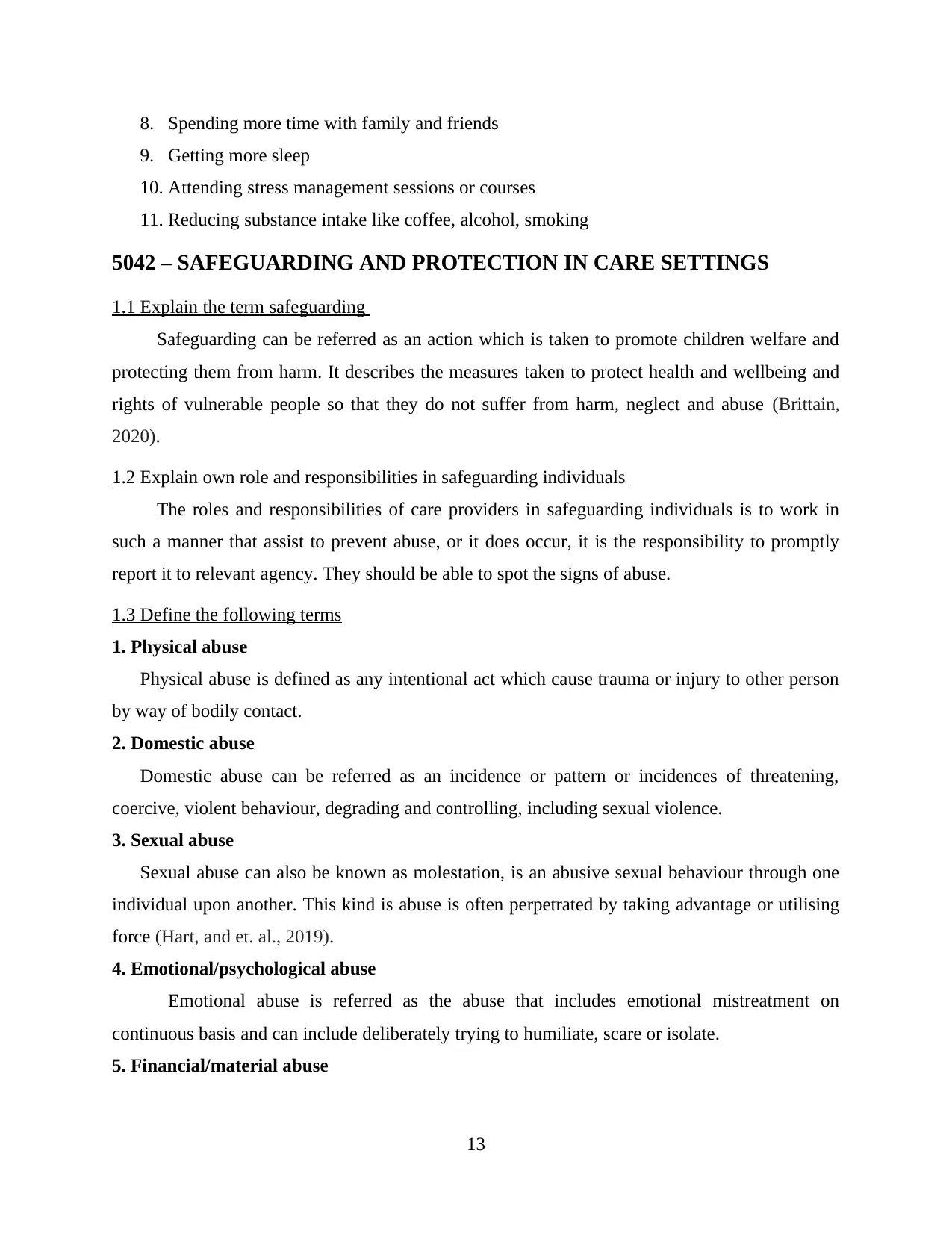
8. Spending more time with family and friends
9. Getting more sleep
10. Attending stress management sessions or courses
11. Reducing substance intake like coffee, alcohol, smoking
5042 – SAFEGUARDING AND PROTECTION IN CARE SETTINGS
1.1 Explain the term safeguarding
Safeguarding can be referred as an action which is taken to promote children welfare and
protecting them from harm. It describes the measures taken to protect health and wellbeing and
rights of vulnerable people so that they do not suffer from harm, neglect and abuse (Brittain,
2020).
1.2 Explain own role and responsibilities in safeguarding individuals
The roles and responsibilities of care providers in safeguarding individuals is to work in
such a manner that assist to prevent abuse, or it does occur, it is the responsibility to promptly
report it to relevant agency. They should be able to spot the signs of abuse.
1.3 Define the following terms
1. Physical abuse
Physical abuse is defined as any intentional act which cause trauma or injury to other person
by way of bodily contact.
2. Domestic abuse
Domestic abuse can be referred as an incidence or pattern or incidences of threatening,
coercive, violent behaviour, degrading and controlling, including sexual violence.
3. Sexual abuse
Sexual abuse can also be known as molestation, is an abusive sexual behaviour through one
individual upon another. This kind is abuse is often perpetrated by taking advantage or utilising
force (Hart, and et. al., 2019).
4. Emotional/psychological abuse
Emotional abuse is referred as the abuse that includes emotional mistreatment on
continuous basis and can include deliberately trying to humiliate, scare or isolate.
5. Financial/material abuse
13
9. Getting more sleep
10. Attending stress management sessions or courses
11. Reducing substance intake like coffee, alcohol, smoking
5042 – SAFEGUARDING AND PROTECTION IN CARE SETTINGS
1.1 Explain the term safeguarding
Safeguarding can be referred as an action which is taken to promote children welfare and
protecting them from harm. It describes the measures taken to protect health and wellbeing and
rights of vulnerable people so that they do not suffer from harm, neglect and abuse (Brittain,
2020).
1.2 Explain own role and responsibilities in safeguarding individuals
The roles and responsibilities of care providers in safeguarding individuals is to work in
such a manner that assist to prevent abuse, or it does occur, it is the responsibility to promptly
report it to relevant agency. They should be able to spot the signs of abuse.
1.3 Define the following terms
1. Physical abuse
Physical abuse is defined as any intentional act which cause trauma or injury to other person
by way of bodily contact.
2. Domestic abuse
Domestic abuse can be referred as an incidence or pattern or incidences of threatening,
coercive, violent behaviour, degrading and controlling, including sexual violence.
3. Sexual abuse
Sexual abuse can also be known as molestation, is an abusive sexual behaviour through one
individual upon another. This kind is abuse is often perpetrated by taking advantage or utilising
force (Hart, and et. al., 2019).
4. Emotional/psychological abuse
Emotional abuse is referred as the abuse that includes emotional mistreatment on
continuous basis and can include deliberately trying to humiliate, scare or isolate.
5. Financial/material abuse
13
Paraphrase This Document
Need a fresh take? Get an instant paraphrase of this document with our AI Paraphraser
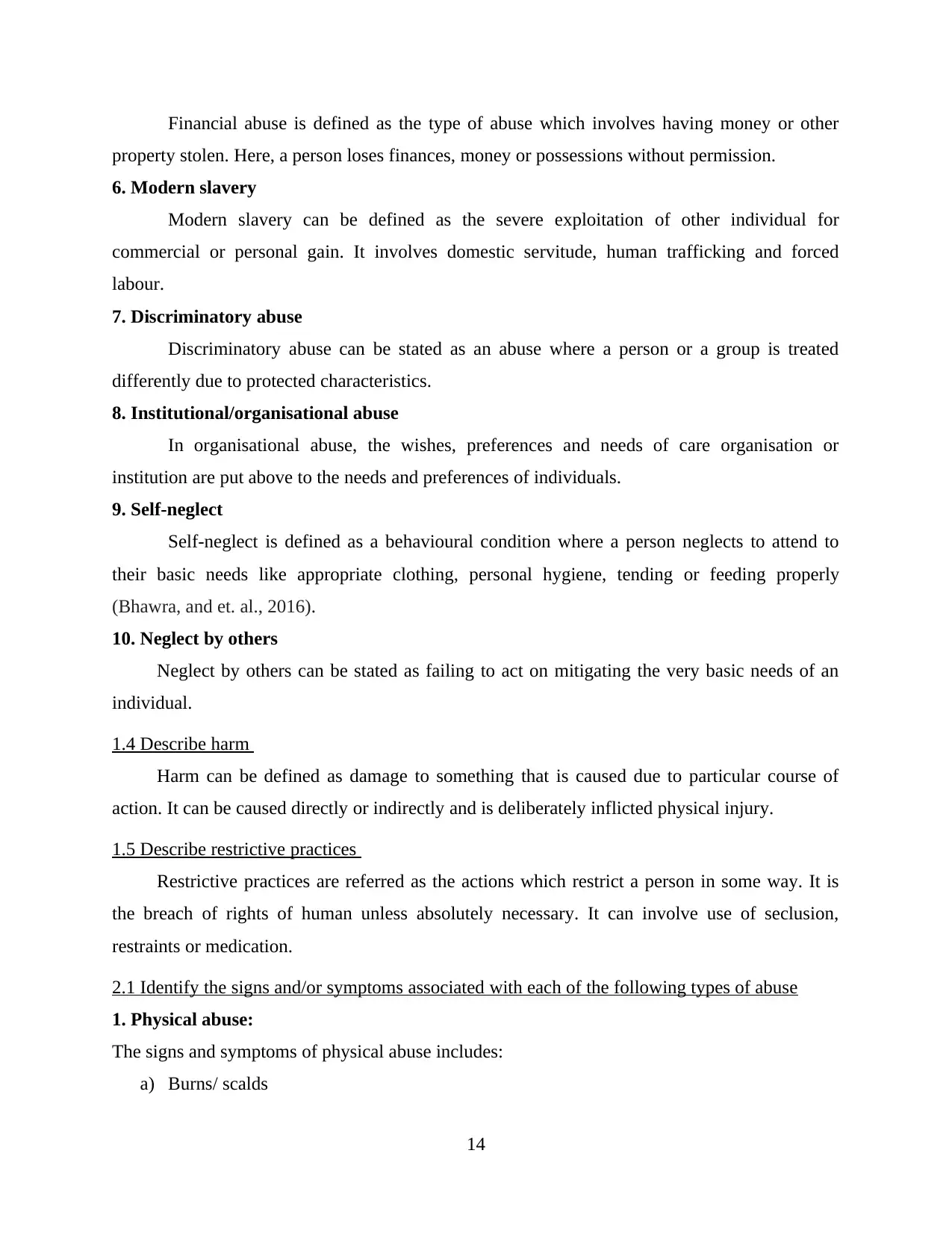
Financial abuse is defined as the type of abuse which involves having money or other
property stolen. Here, a person loses finances, money or possessions without permission.
6. Modern slavery
Modern slavery can be defined as the severe exploitation of other individual for
commercial or personal gain. It involves domestic servitude, human trafficking and forced
labour.
7. Discriminatory abuse
Discriminatory abuse can be stated as an abuse where a person or a group is treated
differently due to protected characteristics.
8. Institutional/organisational abuse
In organisational abuse, the wishes, preferences and needs of care organisation or
institution are put above to the needs and preferences of individuals.
9. Self-neglect
Self-neglect is defined as a behavioural condition where a person neglects to attend to
their basic needs like appropriate clothing, personal hygiene, tending or feeding properly
(Bhawra, and et. al., 2016).
10. Neglect by others
Neglect by others can be stated as failing to act on mitigating the very basic needs of an
individual.
1.4 Describe harm
Harm can be defined as damage to something that is caused due to particular course of
action. It can be caused directly or indirectly and is deliberately inflicted physical injury.
1.5 Describe restrictive practices
Restrictive practices are referred as the actions which restrict a person in some way. It is
the breach of rights of human unless absolutely necessary. It can involve use of seclusion,
restraints or medication.
2.1 Identify the signs and/or symptoms associated with each of the following types of abuse
1. Physical abuse:
The signs and symptoms of physical abuse includes:
a) Burns/ scalds
14
property stolen. Here, a person loses finances, money or possessions without permission.
6. Modern slavery
Modern slavery can be defined as the severe exploitation of other individual for
commercial or personal gain. It involves domestic servitude, human trafficking and forced
labour.
7. Discriminatory abuse
Discriminatory abuse can be stated as an abuse where a person or a group is treated
differently due to protected characteristics.
8. Institutional/organisational abuse
In organisational abuse, the wishes, preferences and needs of care organisation or
institution are put above to the needs and preferences of individuals.
9. Self-neglect
Self-neglect is defined as a behavioural condition where a person neglects to attend to
their basic needs like appropriate clothing, personal hygiene, tending or feeding properly
(Bhawra, and et. al., 2016).
10. Neglect by others
Neglect by others can be stated as failing to act on mitigating the very basic needs of an
individual.
1.4 Describe harm
Harm can be defined as damage to something that is caused due to particular course of
action. It can be caused directly or indirectly and is deliberately inflicted physical injury.
1.5 Describe restrictive practices
Restrictive practices are referred as the actions which restrict a person in some way. It is
the breach of rights of human unless absolutely necessary. It can involve use of seclusion,
restraints or medication.
2.1 Identify the signs and/or symptoms associated with each of the following types of abuse
1. Physical abuse:
The signs and symptoms of physical abuse includes:
a) Burns/ scalds
14
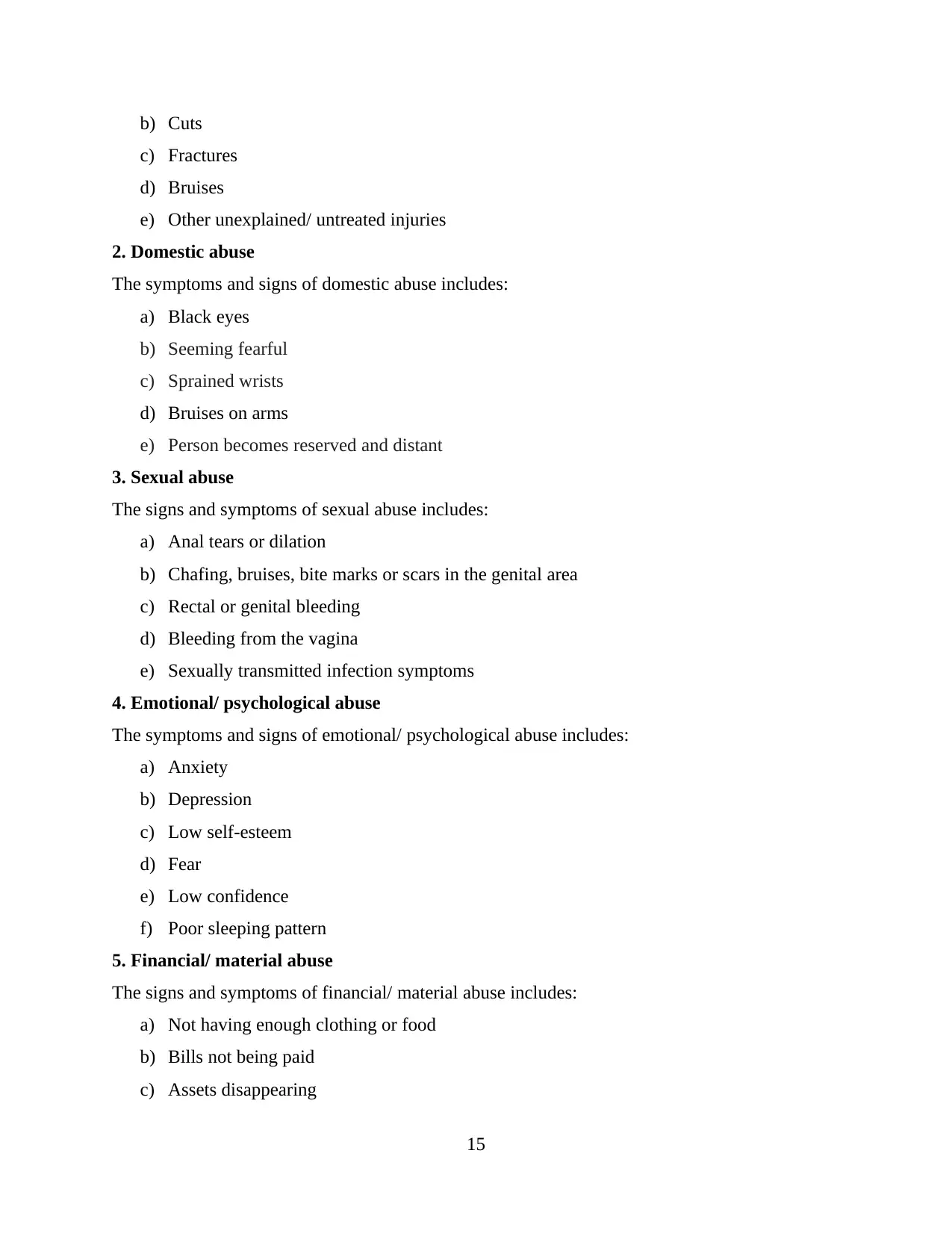
b) Cuts
c) Fractures
d) Bruises
e) Other unexplained/ untreated injuries
2. Domestic abuse
The symptoms and signs of domestic abuse includes:
a) Black eyes
b) Seeming fearful
c) Sprained wrists
d) Bruises on arms
e) Person becomes reserved and distant
3. Sexual abuse
The signs and symptoms of sexual abuse includes:
a) Anal tears or dilation
b) Chafing, bruises, bite marks or scars in the genital area
c) Rectal or genital bleeding
d) Bleeding from the vagina
e) Sexually transmitted infection symptoms
4. Emotional/ psychological abuse
The symptoms and signs of emotional/ psychological abuse includes:
a) Anxiety
b) Depression
c) Low self-esteem
d) Fear
e) Low confidence
f) Poor sleeping pattern
5. Financial/ material abuse
The signs and symptoms of financial/ material abuse includes:
a) Not having enough clothing or food
b) Bills not being paid
c) Assets disappearing
15
c) Fractures
d) Bruises
e) Other unexplained/ untreated injuries
2. Domestic abuse
The symptoms and signs of domestic abuse includes:
a) Black eyes
b) Seeming fearful
c) Sprained wrists
d) Bruises on arms
e) Person becomes reserved and distant
3. Sexual abuse
The signs and symptoms of sexual abuse includes:
a) Anal tears or dilation
b) Chafing, bruises, bite marks or scars in the genital area
c) Rectal or genital bleeding
d) Bleeding from the vagina
e) Sexually transmitted infection symptoms
4. Emotional/ psychological abuse
The symptoms and signs of emotional/ psychological abuse includes:
a) Anxiety
b) Depression
c) Low self-esteem
d) Fear
e) Low confidence
f) Poor sleeping pattern
5. Financial/ material abuse
The signs and symptoms of financial/ material abuse includes:
a) Not having enough clothing or food
b) Bills not being paid
c) Assets disappearing
15
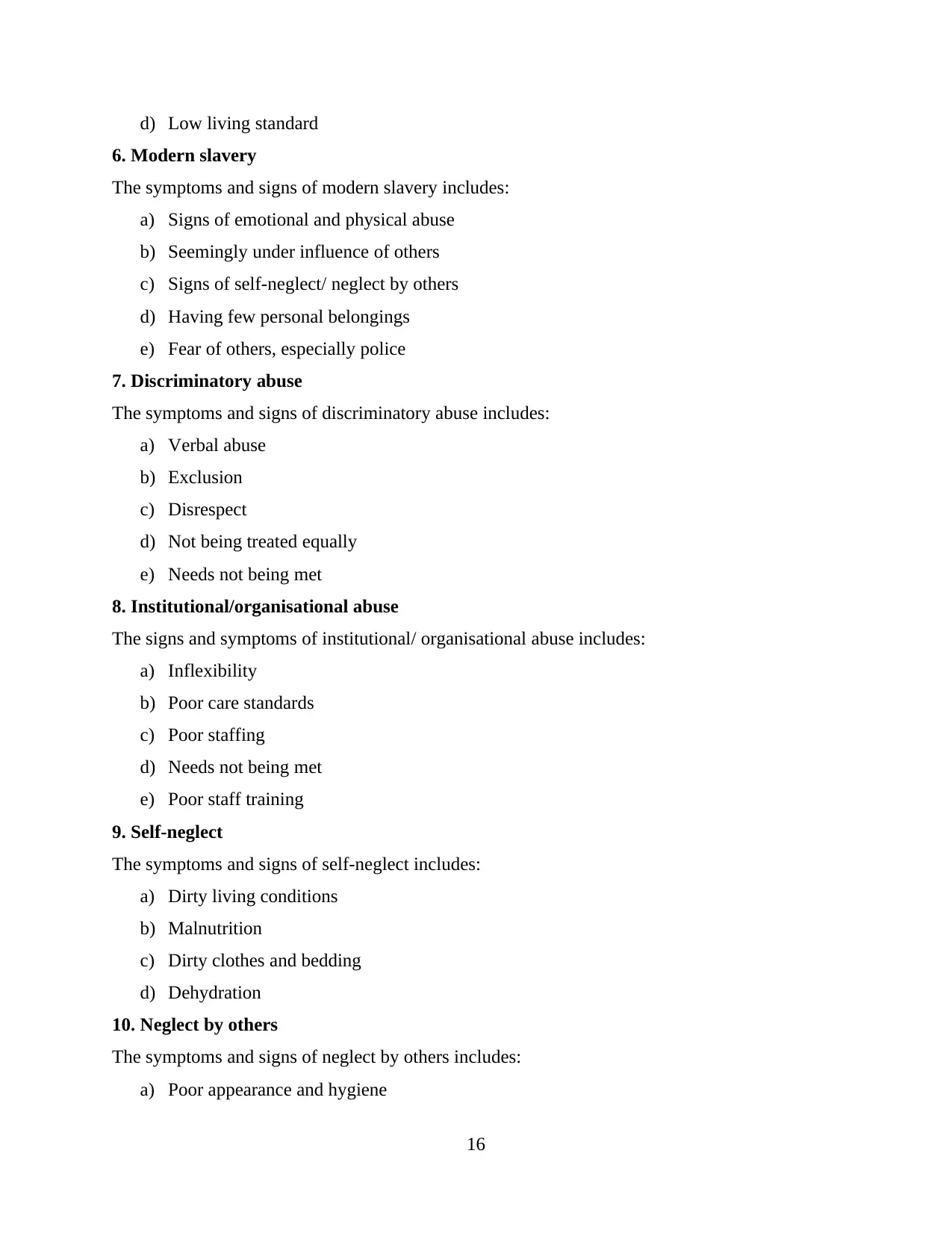
d) Low living standard
6. Modern slavery
The symptoms and signs of modern slavery includes:
a) Signs of emotional and physical abuse
b) Seemingly under influence of others
c) Signs of self-neglect/ neglect by others
d) Having few personal belongings
e) Fear of others, especially police
7. Discriminatory abuse
The symptoms and signs of discriminatory abuse includes:
a) Verbal abuse
b) Exclusion
c) Disrespect
d) Not being treated equally
e) Needs not being met
8. Institutional/organisational abuse
The signs and symptoms of institutional/ organisational abuse includes:
a) Inflexibility
b) Poor care standards
c) Poor staffing
d) Needs not being met
e) Poor staff training
9. Self-neglect
The symptoms and signs of self-neglect includes:
a) Dirty living conditions
b) Malnutrition
c) Dirty clothes and bedding
d) Dehydration
10. Neglect by others
The symptoms and signs of neglect by others includes:
a) Poor appearance and hygiene
16
6. Modern slavery
The symptoms and signs of modern slavery includes:
a) Signs of emotional and physical abuse
b) Seemingly under influence of others
c) Signs of self-neglect/ neglect by others
d) Having few personal belongings
e) Fear of others, especially police
7. Discriminatory abuse
The symptoms and signs of discriminatory abuse includes:
a) Verbal abuse
b) Exclusion
c) Disrespect
d) Not being treated equally
e) Needs not being met
8. Institutional/organisational abuse
The signs and symptoms of institutional/ organisational abuse includes:
a) Inflexibility
b) Poor care standards
c) Poor staffing
d) Needs not being met
e) Poor staff training
9. Self-neglect
The symptoms and signs of self-neglect includes:
a) Dirty living conditions
b) Malnutrition
c) Dirty clothes and bedding
d) Dehydration
10. Neglect by others
The symptoms and signs of neglect by others includes:
a) Poor appearance and hygiene
16
Secure Best Marks with AI Grader
Need help grading? Try our AI Grader for instant feedback on your assignments.

b) Change in behaviour
c) Malnutrition
d) Dirty living conditions
2.2 Describe factors that may contribute to an individual being more vulnerable to abuse
The factors which may contribute to a person being more vulnerable to abuse includes:
1. Low self-esteem or self confidence
2. Lack of education
3. Lack of independence
4. Drug addiction
5. Not having others who care for them
6. Mental health conditions
7. Isolation and social exclusion
8. Communication difficulties
9. Culture, religion and traditions
10. Past experience of abuse
3.1 Explain the actions to take if there are suspicions that an individual is being abused
If suspicions are there that an individual is being abused, then the actions to take includes
report it immediately in line with the agreed ways of working of organisation. Apart from this, in
an emergency situation, the action to protect the individual from harm must be taken.
3.2 Explain the actions to take if an individual alleges that they are being abused
If people alleges that they are being abused, same process which applies in the above
provided part, i.e., actions to take if there is suspicions that person is being abused is applies.
Reporting the issue to manager or safeguarding lead of organisation and follow the safeguarding
policy of organisation in this regard. Apart from this, it is necessary to treat all the allegation
seriously and investigated thoroughly (Gabriel, and et. al., 2017).
3.3 Identify ways to ensure that evidence of abuse is preserved
The ways to ensure that evidence of abuse is preserved includes:
1. Discouraging washing/ bathing
2. Keeping the abuse scene unchanged, perhaps through closing the doors to room it
happened in as well as not entering until police can see it.
17
c) Malnutrition
d) Dirty living conditions
2.2 Describe factors that may contribute to an individual being more vulnerable to abuse
The factors which may contribute to a person being more vulnerable to abuse includes:
1. Low self-esteem or self confidence
2. Lack of education
3. Lack of independence
4. Drug addiction
5. Not having others who care for them
6. Mental health conditions
7. Isolation and social exclusion
8. Communication difficulties
9. Culture, religion and traditions
10. Past experience of abuse
3.1 Explain the actions to take if there are suspicions that an individual is being abused
If suspicions are there that an individual is being abused, then the actions to take includes
report it immediately in line with the agreed ways of working of organisation. Apart from this, in
an emergency situation, the action to protect the individual from harm must be taken.
3.2 Explain the actions to take if an individual alleges that they are being abused
If people alleges that they are being abused, same process which applies in the above
provided part, i.e., actions to take if there is suspicions that person is being abused is applies.
Reporting the issue to manager or safeguarding lead of organisation and follow the safeguarding
policy of organisation in this regard. Apart from this, it is necessary to treat all the allegation
seriously and investigated thoroughly (Gabriel, and et. al., 2017).
3.3 Identify ways to ensure that evidence of abuse is preserved
The ways to ensure that evidence of abuse is preserved includes:
1. Discouraging washing/ bathing
2. Keeping the abuse scene unchanged, perhaps through closing the doors to room it
happened in as well as not entering until police can see it.
17
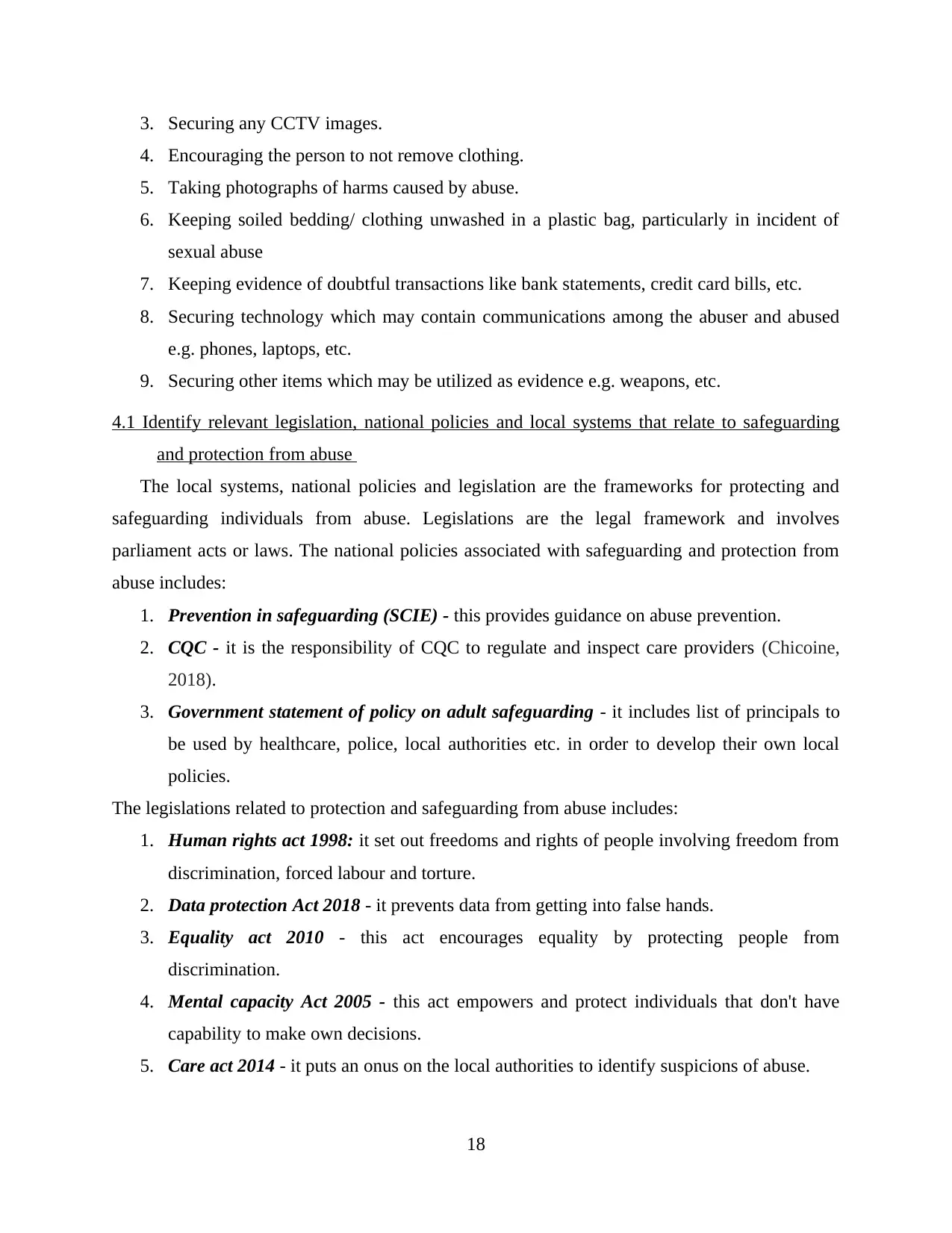
3. Securing any CCTV images.
4. Encouraging the person to not remove clothing.
5. Taking photographs of harms caused by abuse.
6. Keeping soiled bedding/ clothing unwashed in a plastic bag, particularly in incident of
sexual abuse
7. Keeping evidence of doubtful transactions like bank statements, credit card bills, etc.
8. Securing technology which may contain communications among the abuser and abused
e.g. phones, laptops, etc.
9. Securing other items which may be utilized as evidence e.g. weapons, etc.
4.1 Identify relevant legislation, national policies and local systems that relate to safeguarding
and protection from abuse
The local systems, national policies and legislation are the frameworks for protecting and
safeguarding individuals from abuse. Legislations are the legal framework and involves
parliament acts or laws. The national policies associated with safeguarding and protection from
abuse includes:
1. Prevention in safeguarding (SCIE) - this provides guidance on abuse prevention.
2. CQC - it is the responsibility of CQC to regulate and inspect care providers (Chicoine,
2018).
3. Government statement of policy on adult safeguarding - it includes list of principals to
be used by healthcare, police, local authorities etc. in order to develop their own local
policies.
The legislations related to protection and safeguarding from abuse includes:
1. Human rights act 1998: it set out freedoms and rights of people involving freedom from
discrimination, forced labour and torture.
2. Data protection Act 2018 - it prevents data from getting into false hands.
3. Equality act 2010 - this act encourages equality by protecting people from
discrimination.
4. Mental capacity Act 2005 - this act empowers and protect individuals that don't have
capability to make own decisions.
5. Care act 2014 - it puts an onus on the local authorities to identify suspicions of abuse.
18
4. Encouraging the person to not remove clothing.
5. Taking photographs of harms caused by abuse.
6. Keeping soiled bedding/ clothing unwashed in a plastic bag, particularly in incident of
sexual abuse
7. Keeping evidence of doubtful transactions like bank statements, credit card bills, etc.
8. Securing technology which may contain communications among the abuser and abused
e.g. phones, laptops, etc.
9. Securing other items which may be utilized as evidence e.g. weapons, etc.
4.1 Identify relevant legislation, national policies and local systems that relate to safeguarding
and protection from abuse
The local systems, national policies and legislation are the frameworks for protecting and
safeguarding individuals from abuse. Legislations are the legal framework and involves
parliament acts or laws. The national policies associated with safeguarding and protection from
abuse includes:
1. Prevention in safeguarding (SCIE) - this provides guidance on abuse prevention.
2. CQC - it is the responsibility of CQC to regulate and inspect care providers (Chicoine,
2018).
3. Government statement of policy on adult safeguarding - it includes list of principals to
be used by healthcare, police, local authorities etc. in order to develop their own local
policies.
The legislations related to protection and safeguarding from abuse includes:
1. Human rights act 1998: it set out freedoms and rights of people involving freedom from
discrimination, forced labour and torture.
2. Data protection Act 2018 - it prevents data from getting into false hands.
3. Equality act 2010 - this act encourages equality by protecting people from
discrimination.
4. Mental capacity Act 2005 - this act empowers and protect individuals that don't have
capability to make own decisions.
5. Care act 2014 - it puts an onus on the local authorities to identify suspicions of abuse.
18

6. Safeguarding vulnerable groups Act 2006 - it prevents the individuals that may pose a
risk to vulnerable people from having access to them by work.
The local systems are the systems which are in place in region and involves:
1. Police - it has legal responsibility to safeguard or protect vulnerable people.
2. Local authority - it involves social services you should make enquiries regarding reports
of abuse as well as safeguarding boards.
3. Health and social care - people in the sector have responsibility to protect or safeguard
the vulnerable people.
4.2 Explain the roles of different agencies in safeguarding and protecting individuals from abuse
In protecting and safeguarding the individuals from abuse, different agencies play different
role. The health and social care employees on front line have responsibility to report the
suspicions latest abuse in line with the agreed ways of working of organisation. This must be
then reported to local authority who have the responsibility to do welfare checks as well as
investigate the allegations. It is usually carried out by social services department. It has also the
duty of setting up safeguarding boards that look into abuse cases and evaluate the way things
could have been done in better way (Agarwal, and et. al., 2017). On the other hand, the police
have the responsibility to protect welfare of vulnerable people and investigate suspicions of
abuse where crime is committed. It is the responsibility of government to set nationwide policy
and legislation for safeguarding. Moreover, the care quality commission monitor and inspect care
providers to make sure that no abusive practices or activities are being followed.
4.3 Identify factors which have featured in reports into serious cases of abuse and neglect
The factors that have featured in reports into serious cases of neglect and abuse includes:
1. Poorly trained staff
2. Warning signs not being selected on
3. Lack of accountability
4. An unacceptable number of people with learning disabilities and autism being kept in a
health care setting for long periods.
5. Reports of abuse are being ignored
6. Ineffective policies as well as procedures
7. Lack of an unannounced inspections
19
risk to vulnerable people from having access to them by work.
The local systems are the systems which are in place in region and involves:
1. Police - it has legal responsibility to safeguard or protect vulnerable people.
2. Local authority - it involves social services you should make enquiries regarding reports
of abuse as well as safeguarding boards.
3. Health and social care - people in the sector have responsibility to protect or safeguard
the vulnerable people.
4.2 Explain the roles of different agencies in safeguarding and protecting individuals from abuse
In protecting and safeguarding the individuals from abuse, different agencies play different
role. The health and social care employees on front line have responsibility to report the
suspicions latest abuse in line with the agreed ways of working of organisation. This must be
then reported to local authority who have the responsibility to do welfare checks as well as
investigate the allegations. It is usually carried out by social services department. It has also the
duty of setting up safeguarding boards that look into abuse cases and evaluate the way things
could have been done in better way (Agarwal, and et. al., 2017). On the other hand, the police
have the responsibility to protect welfare of vulnerable people and investigate suspicions of
abuse where crime is committed. It is the responsibility of government to set nationwide policy
and legislation for safeguarding. Moreover, the care quality commission monitor and inspect care
providers to make sure that no abusive practices or activities are being followed.
4.3 Identify factors which have featured in reports into serious cases of abuse and neglect
The factors that have featured in reports into serious cases of neglect and abuse includes:
1. Poorly trained staff
2. Warning signs not being selected on
3. Lack of accountability
4. An unacceptable number of people with learning disabilities and autism being kept in a
health care setting for long periods.
5. Reports of abuse are being ignored
6. Ineffective policies as well as procedures
7. Lack of an unannounced inspections
19
Paraphrase This Document
Need a fresh take? Get an instant paraphrase of this document with our AI Paraphraser
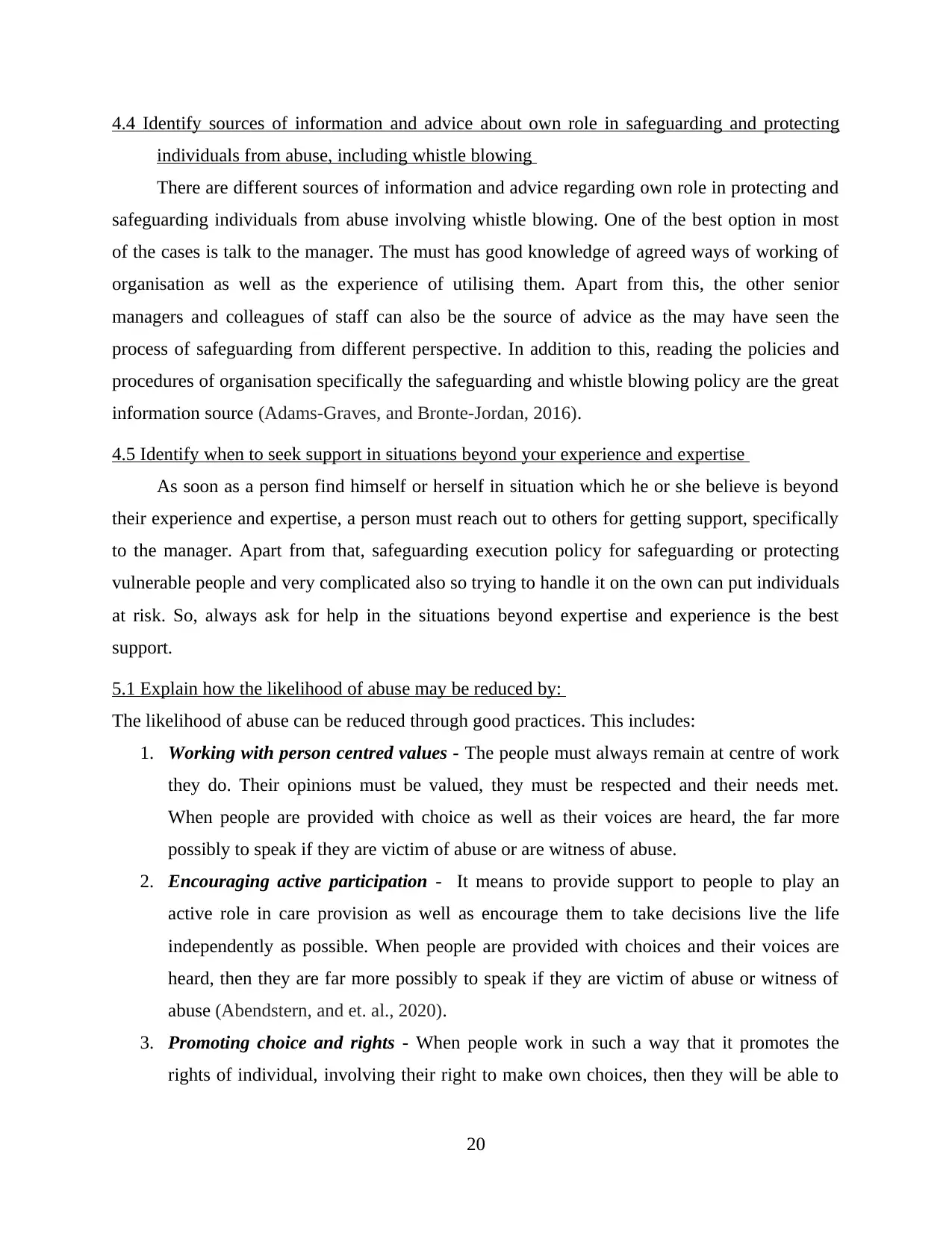
4.4 Identify sources of information and advice about own role in safeguarding and protecting
individuals from abuse, including whistle blowing
There are different sources of information and advice regarding own role in protecting and
safeguarding individuals from abuse involving whistle blowing. One of the best option in most
of the cases is talk to the manager. The must has good knowledge of agreed ways of working of
organisation as well as the experience of utilising them. Apart from this, the other senior
managers and colleagues of staff can also be the source of advice as the may have seen the
process of safeguarding from different perspective. In addition to this, reading the policies and
procedures of organisation specifically the safeguarding and whistle blowing policy are the great
information source (Adams-Graves, and Bronte-Jordan, 2016).
4.5 Identify when to seek support in situations beyond your experience and expertise
As soon as a person find himself or herself in situation which he or she believe is beyond
their experience and expertise, a person must reach out to others for getting support, specifically
to the manager. Apart from that, safeguarding execution policy for safeguarding or protecting
vulnerable people and very complicated also so trying to handle it on the own can put individuals
at risk. So, always ask for help in the situations beyond expertise and experience is the best
support.
5.1 Explain how the likelihood of abuse may be reduced by:
The likelihood of abuse can be reduced through good practices. This includes:
1. Working with person centred values - The people must always remain at centre of work
they do. Their opinions must be valued, they must be respected and their needs met.
When people are provided with choice as well as their voices are heard, the far more
possibly to speak if they are victim of abuse or are witness of abuse.
2. Encouraging active participation - It means to provide support to people to play an
active role in care provision as well as encourage them to take decisions live the life
independently as possible. When people are provided with choices and their voices are
heard, then they are far more possibly to speak if they are victim of abuse or witness of
abuse (Abendstern, and et. al., 2020).
3. Promoting choice and rights - When people work in such a way that it promotes the
rights of individual, involving their right to make own choices, then they will be able to
20
individuals from abuse, including whistle blowing
There are different sources of information and advice regarding own role in protecting and
safeguarding individuals from abuse involving whistle blowing. One of the best option in most
of the cases is talk to the manager. The must has good knowledge of agreed ways of working of
organisation as well as the experience of utilising them. Apart from this, the other senior
managers and colleagues of staff can also be the source of advice as the may have seen the
process of safeguarding from different perspective. In addition to this, reading the policies and
procedures of organisation specifically the safeguarding and whistle blowing policy are the great
information source (Adams-Graves, and Bronte-Jordan, 2016).
4.5 Identify when to seek support in situations beyond your experience and expertise
As soon as a person find himself or herself in situation which he or she believe is beyond
their experience and expertise, a person must reach out to others for getting support, specifically
to the manager. Apart from that, safeguarding execution policy for safeguarding or protecting
vulnerable people and very complicated also so trying to handle it on the own can put individuals
at risk. So, always ask for help in the situations beyond expertise and experience is the best
support.
5.1 Explain how the likelihood of abuse may be reduced by:
The likelihood of abuse can be reduced through good practices. This includes:
1. Working with person centred values - The people must always remain at centre of work
they do. Their opinions must be valued, they must be respected and their needs met.
When people are provided with choice as well as their voices are heard, the far more
possibly to speak if they are victim of abuse or are witness of abuse.
2. Encouraging active participation - It means to provide support to people to play an
active role in care provision as well as encourage them to take decisions live the life
independently as possible. When people are provided with choices and their voices are
heard, then they are far more possibly to speak if they are victim of abuse or witness of
abuse (Abendstern, and et. al., 2020).
3. Promoting choice and rights - When people work in such a way that it promotes the
rights of individual, involving their right to make own choices, then they will be able to
20
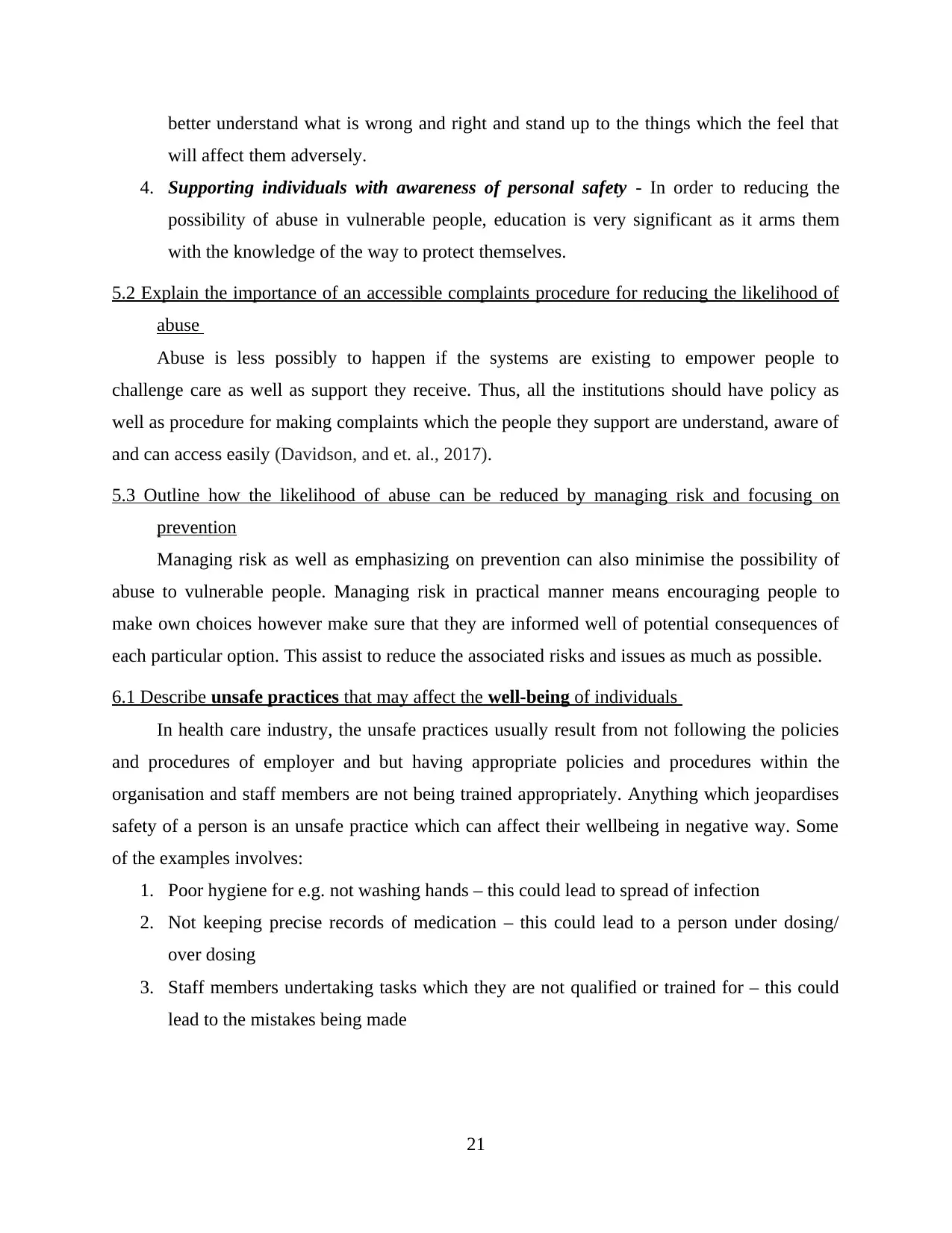
better understand what is wrong and right and stand up to the things which the feel that
will affect them adversely.
4. Supporting individuals with awareness of personal safety - In order to reducing the
possibility of abuse in vulnerable people, education is very significant as it arms them
with the knowledge of the way to protect themselves.
5.2 Explain the importance of an accessible complaints procedure for reducing the likelihood of
abuse
Abuse is less possibly to happen if the systems are existing to empower people to
challenge care as well as support they receive. Thus, all the institutions should have policy as
well as procedure for making complaints which the people they support are understand, aware of
and can access easily (Davidson, and et. al., 2017).
5.3 Outline how the likelihood of abuse can be reduced by managing risk and focusing on
prevention
Managing risk as well as emphasizing on prevention can also minimise the possibility of
abuse to vulnerable people. Managing risk in practical manner means encouraging people to
make own choices however make sure that they are informed well of potential consequences of
each particular option. This assist to reduce the associated risks and issues as much as possible.
6.1 Describe unsafe practices that may affect the well-being of individuals
In health care industry, the unsafe practices usually result from not following the policies
and procedures of employer and but having appropriate policies and procedures within the
organisation and staff members are not being trained appropriately. Anything which jeopardises
safety of a person is an unsafe practice which can affect their wellbeing in negative way. Some
of the examples involves:
1. Poor hygiene for e.g. not washing hands – this could lead to spread of infection
2. Not keeping precise records of medication – this could lead to a person under dosing/
over dosing
3. Staff members undertaking tasks which they are not qualified or trained for – this could
lead to the mistakes being made
21
will affect them adversely.
4. Supporting individuals with awareness of personal safety - In order to reducing the
possibility of abuse in vulnerable people, education is very significant as it arms them
with the knowledge of the way to protect themselves.
5.2 Explain the importance of an accessible complaints procedure for reducing the likelihood of
abuse
Abuse is less possibly to happen if the systems are existing to empower people to
challenge care as well as support they receive. Thus, all the institutions should have policy as
well as procedure for making complaints which the people they support are understand, aware of
and can access easily (Davidson, and et. al., 2017).
5.3 Outline how the likelihood of abuse can be reduced by managing risk and focusing on
prevention
Managing risk as well as emphasizing on prevention can also minimise the possibility of
abuse to vulnerable people. Managing risk in practical manner means encouraging people to
make own choices however make sure that they are informed well of potential consequences of
each particular option. This assist to reduce the associated risks and issues as much as possible.
6.1 Describe unsafe practices that may affect the well-being of individuals
In health care industry, the unsafe practices usually result from not following the policies
and procedures of employer and but having appropriate policies and procedures within the
organisation and staff members are not being trained appropriately. Anything which jeopardises
safety of a person is an unsafe practice which can affect their wellbeing in negative way. Some
of the examples involves:
1. Poor hygiene for e.g. not washing hands – this could lead to spread of infection
2. Not keeping precise records of medication – this could lead to a person under dosing/
over dosing
3. Staff members undertaking tasks which they are not qualified or trained for – this could
lead to the mistakes being made
21
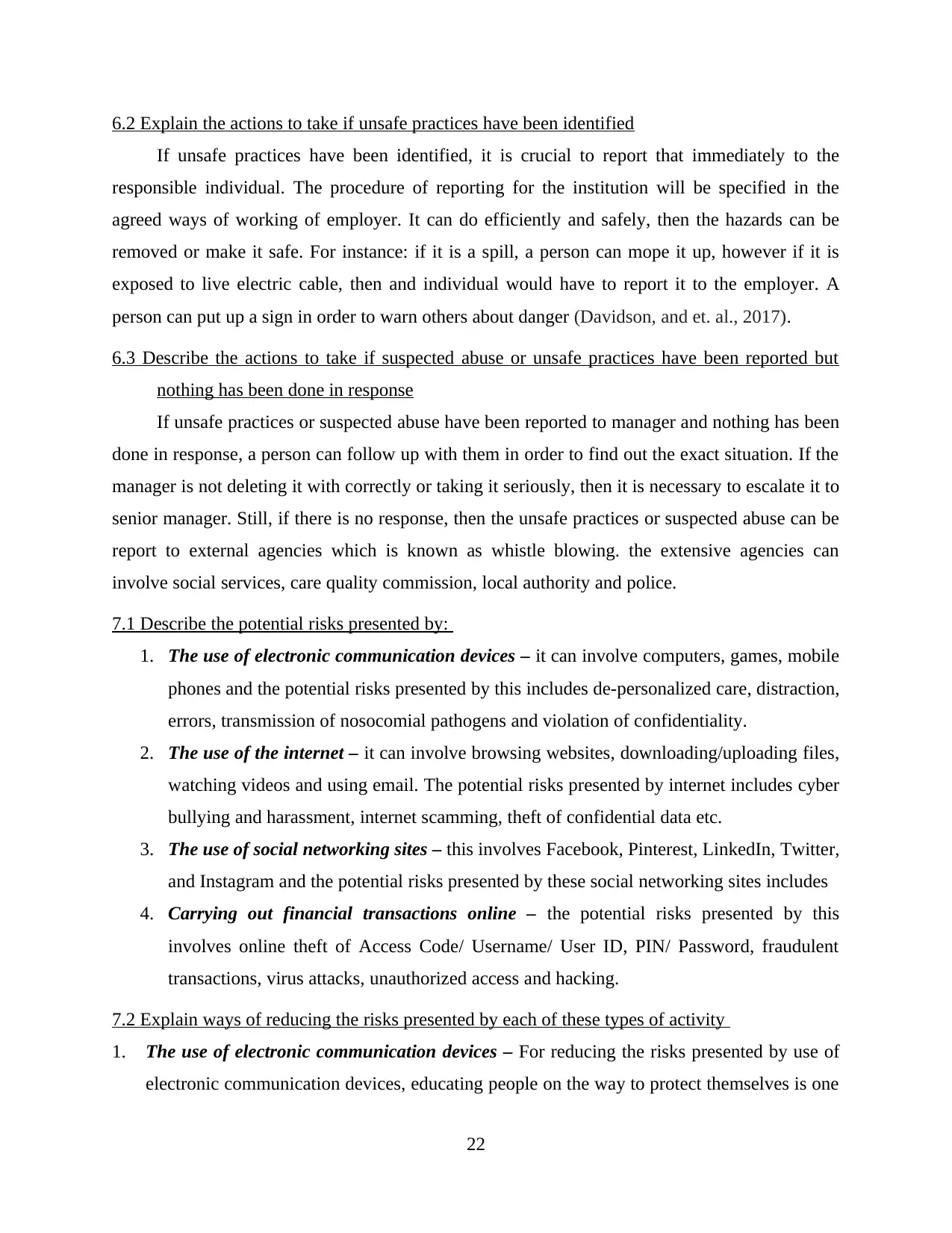
6.2 Explain the actions to take if unsafe practices have been identified
If unsafe practices have been identified, it is crucial to report that immediately to the
responsible individual. The procedure of reporting for the institution will be specified in the
agreed ways of working of employer. It can do efficiently and safely, then the hazards can be
removed or make it safe. For instance: if it is a spill, a person can mope it up, however if it is
exposed to live electric cable, then and individual would have to report it to the employer. A
person can put up a sign in order to warn others about danger (Davidson, and et. al., 2017).
6.3 Describe the actions to take if suspected abuse or unsafe practices have been reported but
nothing has been done in response
If unsafe practices or suspected abuse have been reported to manager and nothing has been
done in response, a person can follow up with them in order to find out the exact situation. If the
manager is not deleting it with correctly or taking it seriously, then it is necessary to escalate it to
senior manager. Still, if there is no response, then the unsafe practices or suspected abuse can be
report to external agencies which is known as whistle blowing. the extensive agencies can
involve social services, care quality commission, local authority and police.
7.1 Describe the potential risks presented by:
1. The use of electronic communication devices – it can involve computers, games, mobile
phones and the potential risks presented by this includes de-personalized care, distraction,
errors, transmission of nosocomial pathogens and violation of confidentiality.
2. The use of the internet – it can involve browsing websites, downloading/uploading files,
watching videos and using email. The potential risks presented by internet includes cyber
bullying and harassment, internet scamming, theft of confidential data etc.
3. The use of social networking sites – this involves Facebook, Pinterest, LinkedIn, Twitter,
and Instagram and the potential risks presented by these social networking sites includes
4. Carrying out financial transactions online – the potential risks presented by this
involves online theft of Access Code/ Username/ User ID, PIN/ Password, fraudulent
transactions, virus attacks, unauthorized access and hacking.
7.2 Explain ways of reducing the risks presented by each of these types of activity
1. The use of electronic communication devices – For reducing the risks presented by use of
electronic communication devices, educating people on the way to protect themselves is one
22
If unsafe practices have been identified, it is crucial to report that immediately to the
responsible individual. The procedure of reporting for the institution will be specified in the
agreed ways of working of employer. It can do efficiently and safely, then the hazards can be
removed or make it safe. For instance: if it is a spill, a person can mope it up, however if it is
exposed to live electric cable, then and individual would have to report it to the employer. A
person can put up a sign in order to warn others about danger (Davidson, and et. al., 2017).
6.3 Describe the actions to take if suspected abuse or unsafe practices have been reported but
nothing has been done in response
If unsafe practices or suspected abuse have been reported to manager and nothing has been
done in response, a person can follow up with them in order to find out the exact situation. If the
manager is not deleting it with correctly or taking it seriously, then it is necessary to escalate it to
senior manager. Still, if there is no response, then the unsafe practices or suspected abuse can be
report to external agencies which is known as whistle blowing. the extensive agencies can
involve social services, care quality commission, local authority and police.
7.1 Describe the potential risks presented by:
1. The use of electronic communication devices – it can involve computers, games, mobile
phones and the potential risks presented by this includes de-personalized care, distraction,
errors, transmission of nosocomial pathogens and violation of confidentiality.
2. The use of the internet – it can involve browsing websites, downloading/uploading files,
watching videos and using email. The potential risks presented by internet includes cyber
bullying and harassment, internet scamming, theft of confidential data etc.
3. The use of social networking sites – this involves Facebook, Pinterest, LinkedIn, Twitter,
and Instagram and the potential risks presented by these social networking sites includes
4. Carrying out financial transactions online – the potential risks presented by this
involves online theft of Access Code/ Username/ User ID, PIN/ Password, fraudulent
transactions, virus attacks, unauthorized access and hacking.
7.2 Explain ways of reducing the risks presented by each of these types of activity
1. The use of electronic communication devices – For reducing the risks presented by use of
electronic communication devices, educating people on the way to protect themselves is one
22
Secure Best Marks with AI Grader
Need help grading? Try our AI Grader for instant feedback on your assignments.
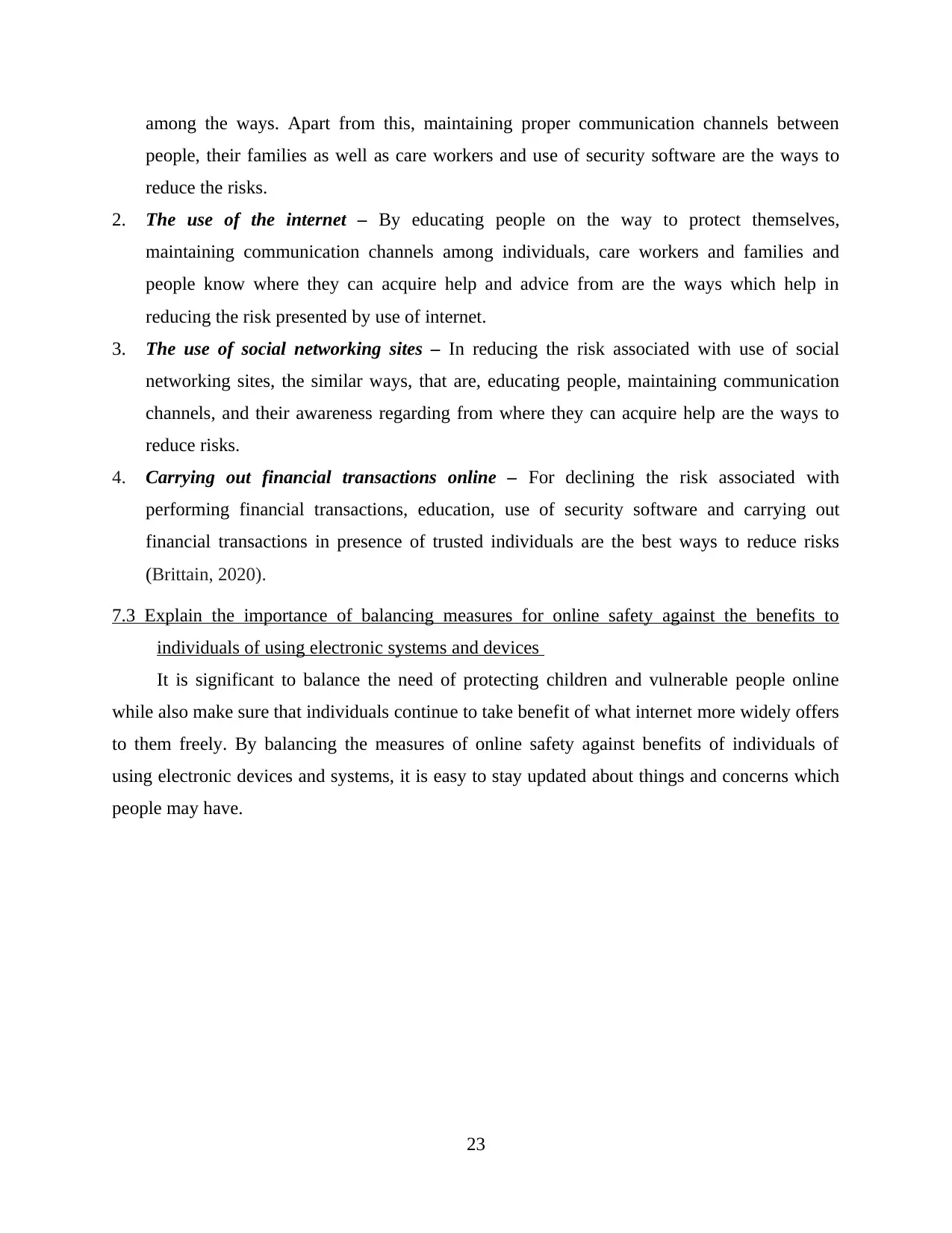
among the ways. Apart from this, maintaining proper communication channels between
people, their families as well as care workers and use of security software are the ways to
reduce the risks.
2. The use of the internet – By educating people on the way to protect themselves,
maintaining communication channels among individuals, care workers and families and
people know where they can acquire help and advice from are the ways which help in
reducing the risk presented by use of internet.
3. The use of social networking sites – In reducing the risk associated with use of social
networking sites, the similar ways, that are, educating people, maintaining communication
channels, and their awareness regarding from where they can acquire help are the ways to
reduce risks.
4. Carrying out financial transactions online – For declining the risk associated with
performing financial transactions, education, use of security software and carrying out
financial transactions in presence of trusted individuals are the best ways to reduce risks
(Brittain, 2020).
7.3 Explain the importance of balancing measures for online safety against the benefits to
individuals of using electronic systems and devices
It is significant to balance the need of protecting children and vulnerable people online
while also make sure that individuals continue to take benefit of what internet more widely offers
to them freely. By balancing the measures of online safety against benefits of individuals of
using electronic devices and systems, it is easy to stay updated about things and concerns which
people may have.
23
people, their families as well as care workers and use of security software are the ways to
reduce the risks.
2. The use of the internet – By educating people on the way to protect themselves,
maintaining communication channels among individuals, care workers and families and
people know where they can acquire help and advice from are the ways which help in
reducing the risk presented by use of internet.
3. The use of social networking sites – In reducing the risk associated with use of social
networking sites, the similar ways, that are, educating people, maintaining communication
channels, and their awareness regarding from where they can acquire help are the ways to
reduce risks.
4. Carrying out financial transactions online – For declining the risk associated with
performing financial transactions, education, use of security software and carrying out
financial transactions in presence of trusted individuals are the best ways to reduce risks
(Brittain, 2020).
7.3 Explain the importance of balancing measures for online safety against the benefits to
individuals of using electronic systems and devices
It is significant to balance the need of protecting children and vulnerable people online
while also make sure that individuals continue to take benefit of what internet more widely offers
to them freely. By balancing the measures of online safety against benefits of individuals of
using electronic devices and systems, it is easy to stay updated about things and concerns which
people may have.
23
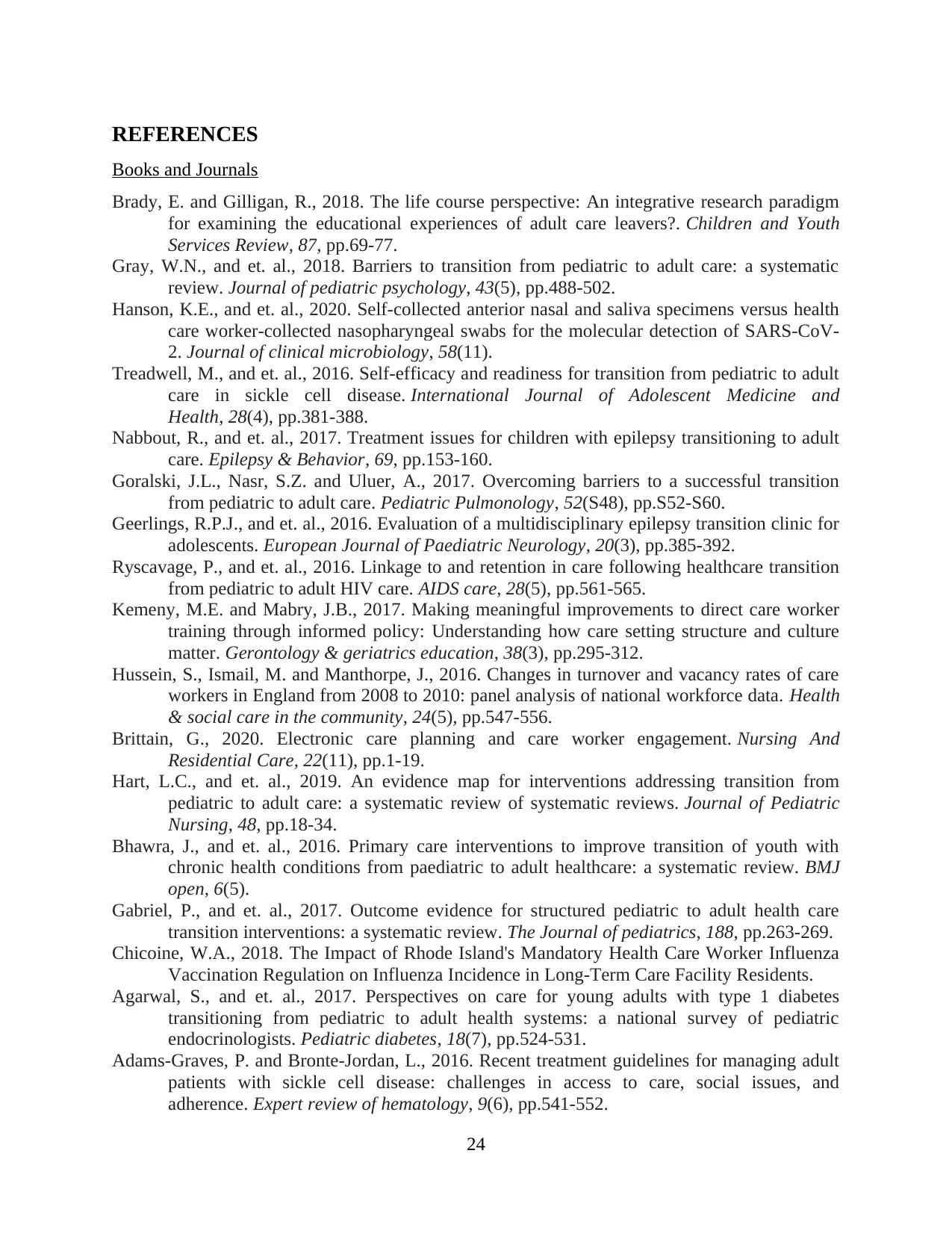
REFERENCES
Books and Journals
Brady, E. and Gilligan, R., 2018. The life course perspective: An integrative research paradigm
for examining the educational experiences of adult care leavers?. Children and Youth
Services Review, 87, pp.69-77.
Gray, W.N., and et. al., 2018. Barriers to transition from pediatric to adult care: a systematic
review. Journal of pediatric psychology, 43(5), pp.488-502.
Hanson, K.E., and et. al., 2020. Self-collected anterior nasal and saliva specimens versus health
care worker-collected nasopharyngeal swabs for the molecular detection of SARS-CoV-
2. Journal of clinical microbiology, 58(11).
Treadwell, M., and et. al., 2016. Self-efficacy and readiness for transition from pediatric to adult
care in sickle cell disease. International Journal of Adolescent Medicine and
Health, 28(4), pp.381-388.
Nabbout, R., and et. al., 2017. Treatment issues for children with epilepsy transitioning to adult
care. Epilepsy & Behavior, 69, pp.153-160.
Goralski, J.L., Nasr, S.Z. and Uluer, A., 2017. Overcoming barriers to a successful transition
from pediatric to adult care. Pediatric Pulmonology, 52(S48), pp.S52-S60.
Geerlings, R.P.J., and et. al., 2016. Evaluation of a multidisciplinary epilepsy transition clinic for
adolescents. European Journal of Paediatric Neurology, 20(3), pp.385-392.
Ryscavage, P., and et. al., 2016. Linkage to and retention in care following healthcare transition
from pediatric to adult HIV care. AIDS care, 28(5), pp.561-565.
Kemeny, M.E. and Mabry, J.B., 2017. Making meaningful improvements to direct care worker
training through informed policy: Understanding how care setting structure and culture
matter. Gerontology & geriatrics education, 38(3), pp.295-312.
Hussein, S., Ismail, M. and Manthorpe, J., 2016. Changes in turnover and vacancy rates of care
workers in England from 2008 to 2010: panel analysis of national workforce data. Health
& social care in the community, 24(5), pp.547-556.
Brittain, G., 2020. Electronic care planning and care worker engagement. Nursing And
Residential Care, 22(11), pp.1-19.
Hart, L.C., and et. al., 2019. An evidence map for interventions addressing transition from
pediatric to adult care: a systematic review of systematic reviews. Journal of Pediatric
Nursing, 48, pp.18-34.
Bhawra, J., and et. al., 2016. Primary care interventions to improve transition of youth with
chronic health conditions from paediatric to adult healthcare: a systematic review. BMJ
open, 6(5).
Gabriel, P., and et. al., 2017. Outcome evidence for structured pediatric to adult health care
transition interventions: a systematic review. The Journal of pediatrics, 188, pp.263-269.
Chicoine, W.A., 2018. The Impact of Rhode Island's Mandatory Health Care Worker Influenza
Vaccination Regulation on Influenza Incidence in Long-Term Care Facility Residents.
Agarwal, S., and et. al., 2017. Perspectives on care for young adults with type 1 diabetes
transitioning from pediatric to adult health systems: a national survey of pediatric
endocrinologists. Pediatric diabetes, 18(7), pp.524-531.
Adams-Graves, P. and Bronte-Jordan, L., 2016. Recent treatment guidelines for managing adult
patients with sickle cell disease: challenges in access to care, social issues, and
adherence. Expert review of hematology, 9(6), pp.541-552.
24
Books and Journals
Brady, E. and Gilligan, R., 2018. The life course perspective: An integrative research paradigm
for examining the educational experiences of adult care leavers?. Children and Youth
Services Review, 87, pp.69-77.
Gray, W.N., and et. al., 2018. Barriers to transition from pediatric to adult care: a systematic
review. Journal of pediatric psychology, 43(5), pp.488-502.
Hanson, K.E., and et. al., 2020. Self-collected anterior nasal and saliva specimens versus health
care worker-collected nasopharyngeal swabs for the molecular detection of SARS-CoV-
2. Journal of clinical microbiology, 58(11).
Treadwell, M., and et. al., 2016. Self-efficacy and readiness for transition from pediatric to adult
care in sickle cell disease. International Journal of Adolescent Medicine and
Health, 28(4), pp.381-388.
Nabbout, R., and et. al., 2017. Treatment issues for children with epilepsy transitioning to adult
care. Epilepsy & Behavior, 69, pp.153-160.
Goralski, J.L., Nasr, S.Z. and Uluer, A., 2017. Overcoming barriers to a successful transition
from pediatric to adult care. Pediatric Pulmonology, 52(S48), pp.S52-S60.
Geerlings, R.P.J., and et. al., 2016. Evaluation of a multidisciplinary epilepsy transition clinic for
adolescents. European Journal of Paediatric Neurology, 20(3), pp.385-392.
Ryscavage, P., and et. al., 2016. Linkage to and retention in care following healthcare transition
from pediatric to adult HIV care. AIDS care, 28(5), pp.561-565.
Kemeny, M.E. and Mabry, J.B., 2017. Making meaningful improvements to direct care worker
training through informed policy: Understanding how care setting structure and culture
matter. Gerontology & geriatrics education, 38(3), pp.295-312.
Hussein, S., Ismail, M. and Manthorpe, J., 2016. Changes in turnover and vacancy rates of care
workers in England from 2008 to 2010: panel analysis of national workforce data. Health
& social care in the community, 24(5), pp.547-556.
Brittain, G., 2020. Electronic care planning and care worker engagement. Nursing And
Residential Care, 22(11), pp.1-19.
Hart, L.C., and et. al., 2019. An evidence map for interventions addressing transition from
pediatric to adult care: a systematic review of systematic reviews. Journal of Pediatric
Nursing, 48, pp.18-34.
Bhawra, J., and et. al., 2016. Primary care interventions to improve transition of youth with
chronic health conditions from paediatric to adult healthcare: a systematic review. BMJ
open, 6(5).
Gabriel, P., and et. al., 2017. Outcome evidence for structured pediatric to adult health care
transition interventions: a systematic review. The Journal of pediatrics, 188, pp.263-269.
Chicoine, W.A., 2018. The Impact of Rhode Island's Mandatory Health Care Worker Influenza
Vaccination Regulation on Influenza Incidence in Long-Term Care Facility Residents.
Agarwal, S., and et. al., 2017. Perspectives on care for young adults with type 1 diabetes
transitioning from pediatric to adult health systems: a national survey of pediatric
endocrinologists. Pediatric diabetes, 18(7), pp.524-531.
Adams-Graves, P. and Bronte-Jordan, L., 2016. Recent treatment guidelines for managing adult
patients with sickle cell disease: challenges in access to care, social issues, and
adherence. Expert review of hematology, 9(6), pp.541-552.
24
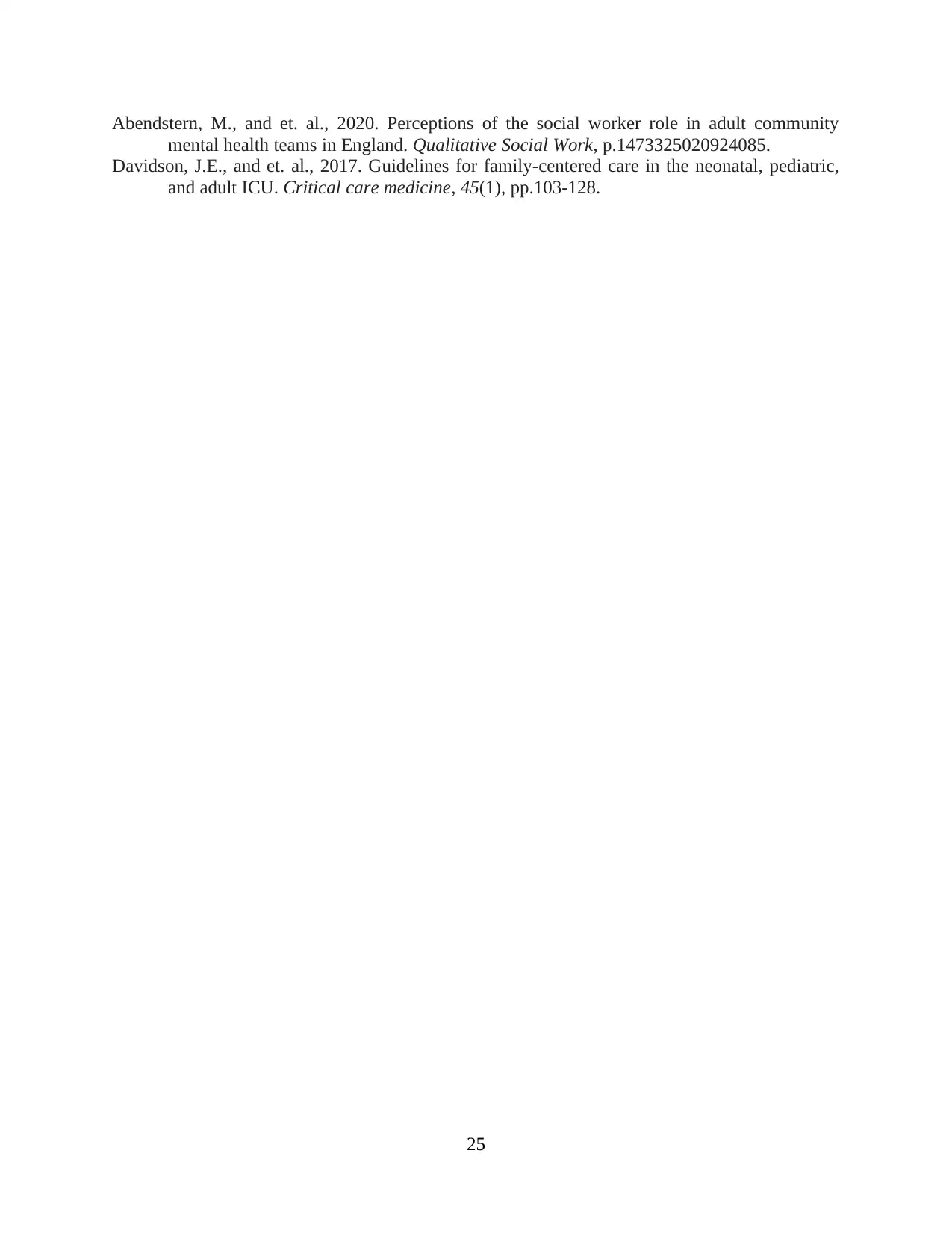
Abendstern, M., and et. al., 2020. Perceptions of the social worker role in adult community
mental health teams in England. Qualitative Social Work, p.1473325020924085.
Davidson, J.E., and et. al., 2017. Guidelines for family-centered care in the neonatal, pediatric,
and adult ICU. Critical care medicine, 45(1), pp.103-128.
25
mental health teams in England. Qualitative Social Work, p.1473325020924085.
Davidson, J.E., and et. al., 2017. Guidelines for family-centered care in the neonatal, pediatric,
and adult ICU. Critical care medicine, 45(1), pp.103-128.
25
1 out of 25
Related Documents
Your All-in-One AI-Powered Toolkit for Academic Success.
+13062052269
info@desklib.com
Available 24*7 on WhatsApp / Email
![[object Object]](/_next/static/media/star-bottom.7253800d.svg)
Unlock your academic potential
© 2024 | Zucol Services PVT LTD | All rights reserved.





